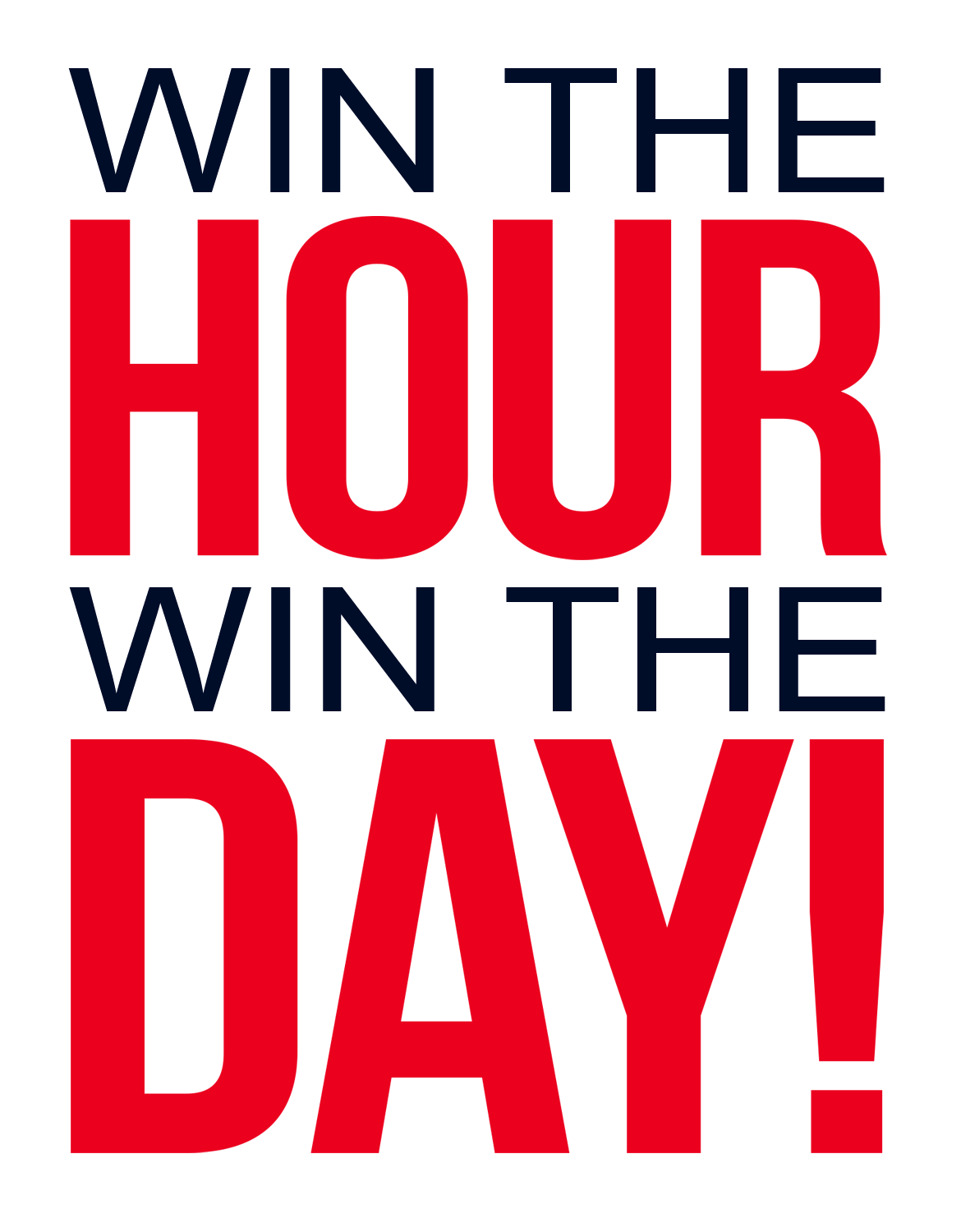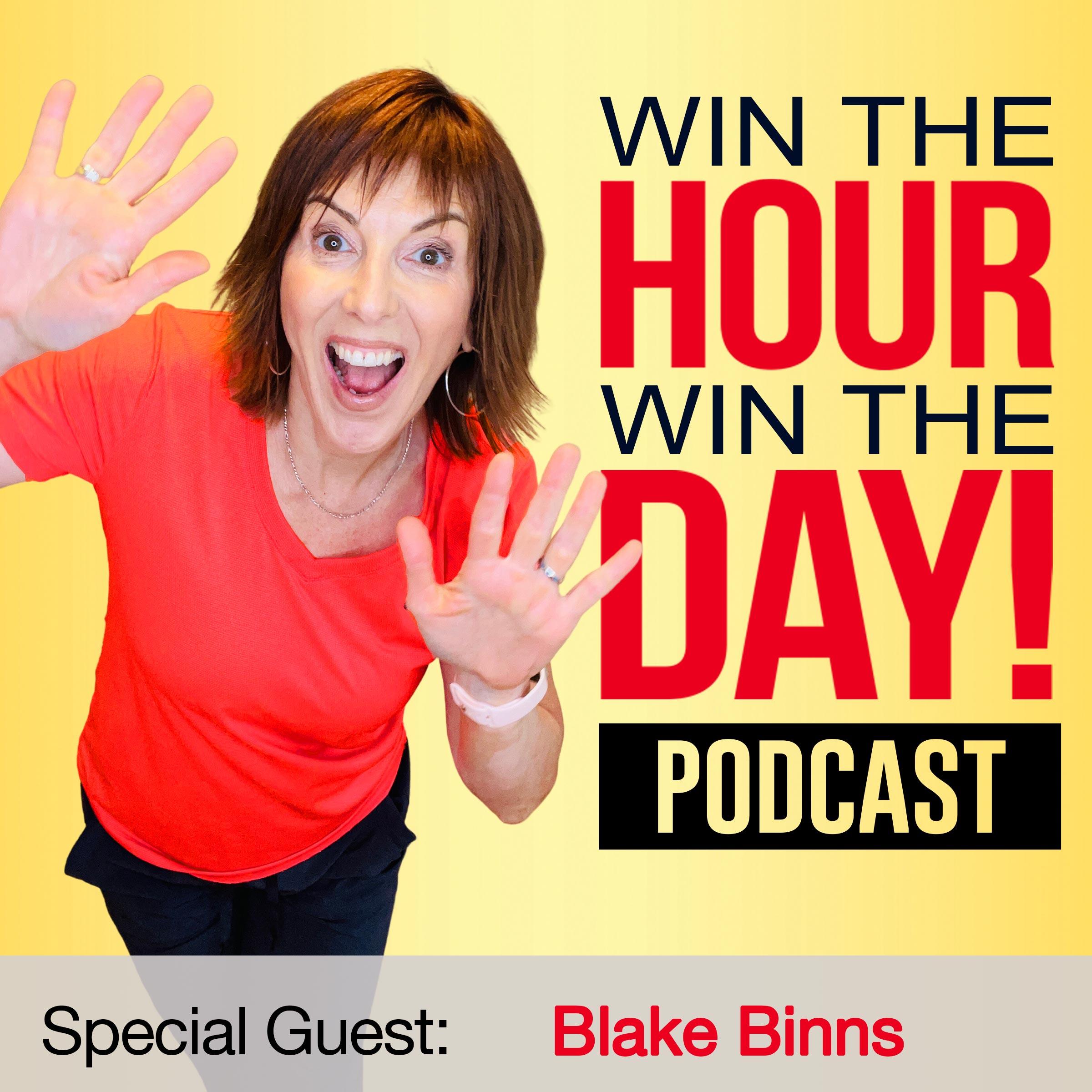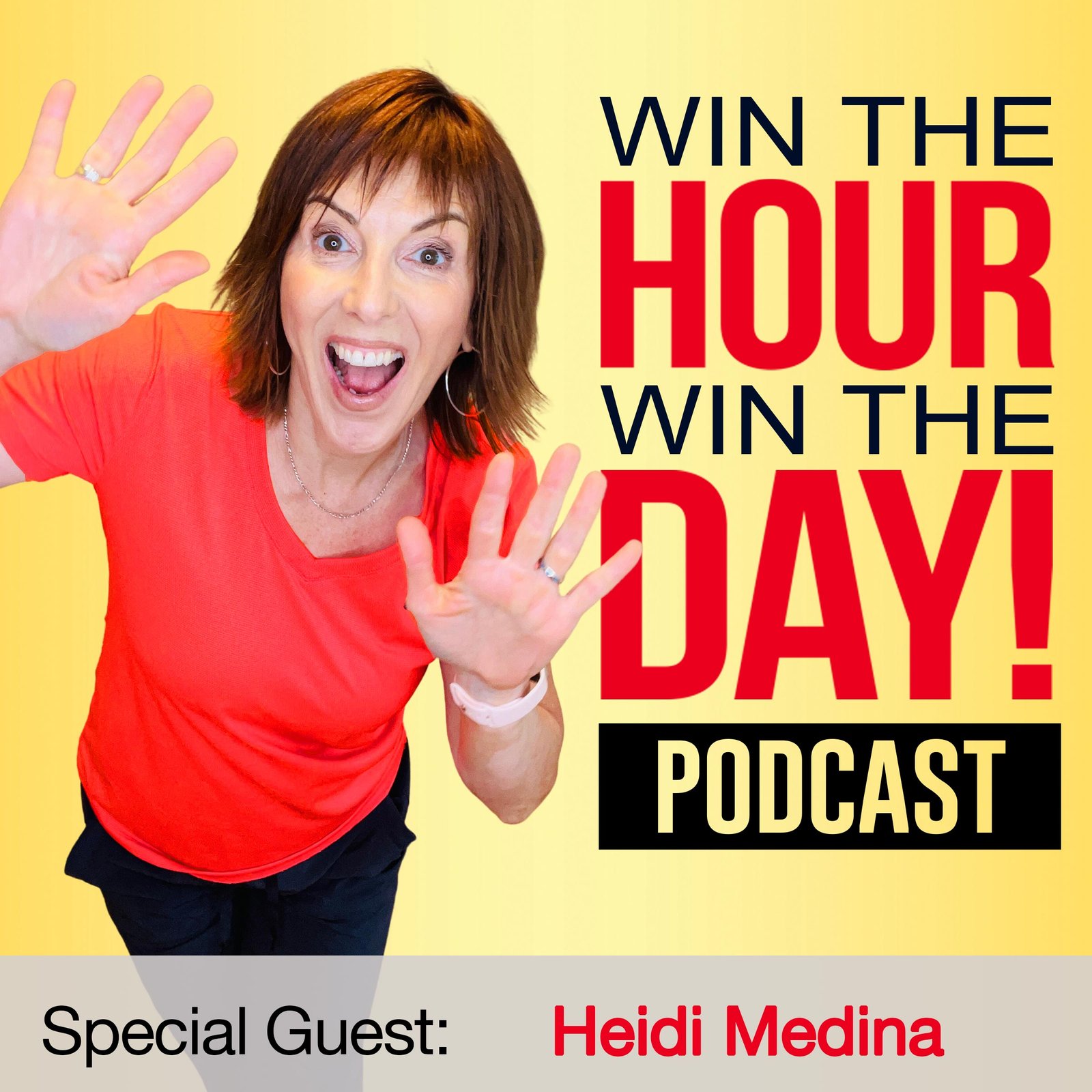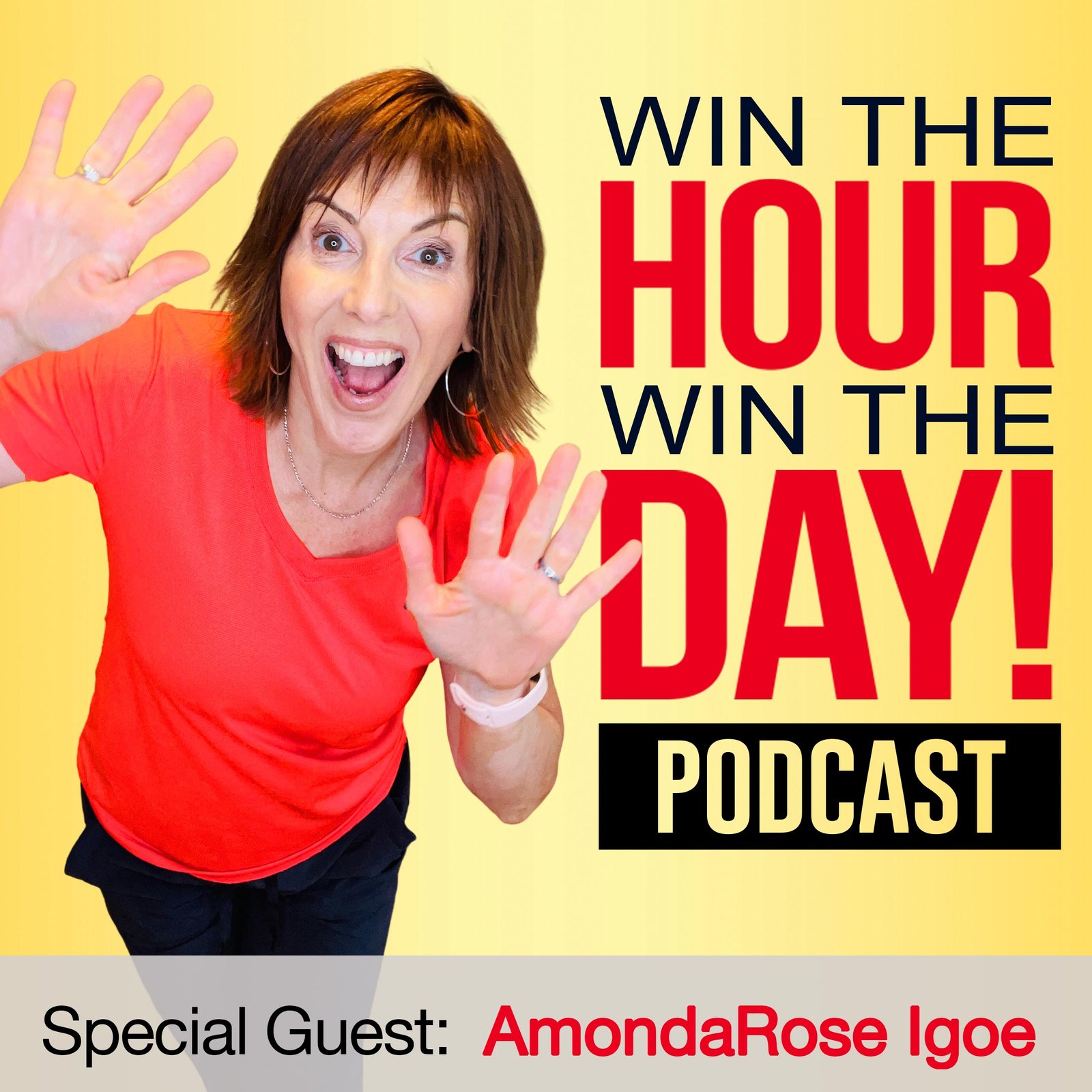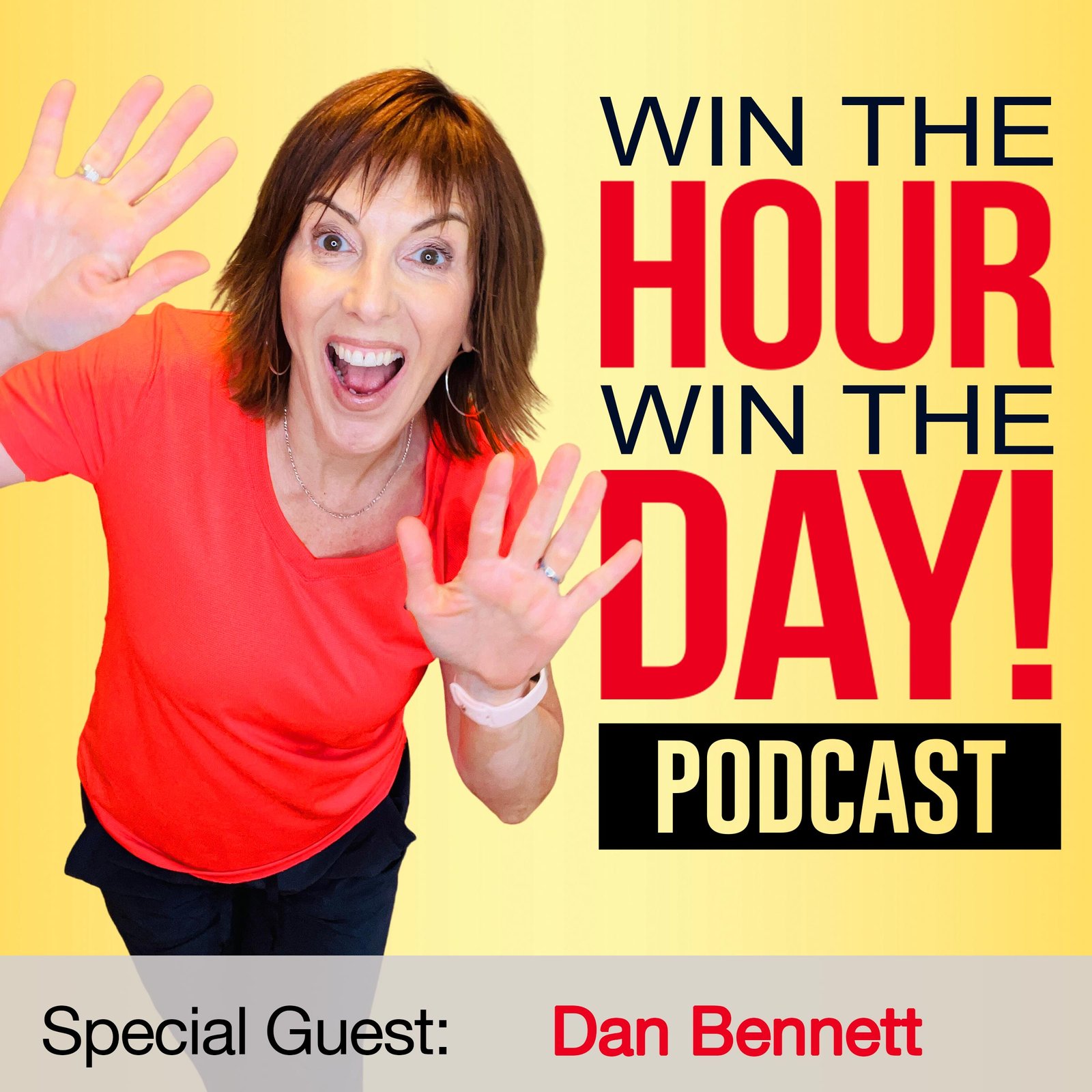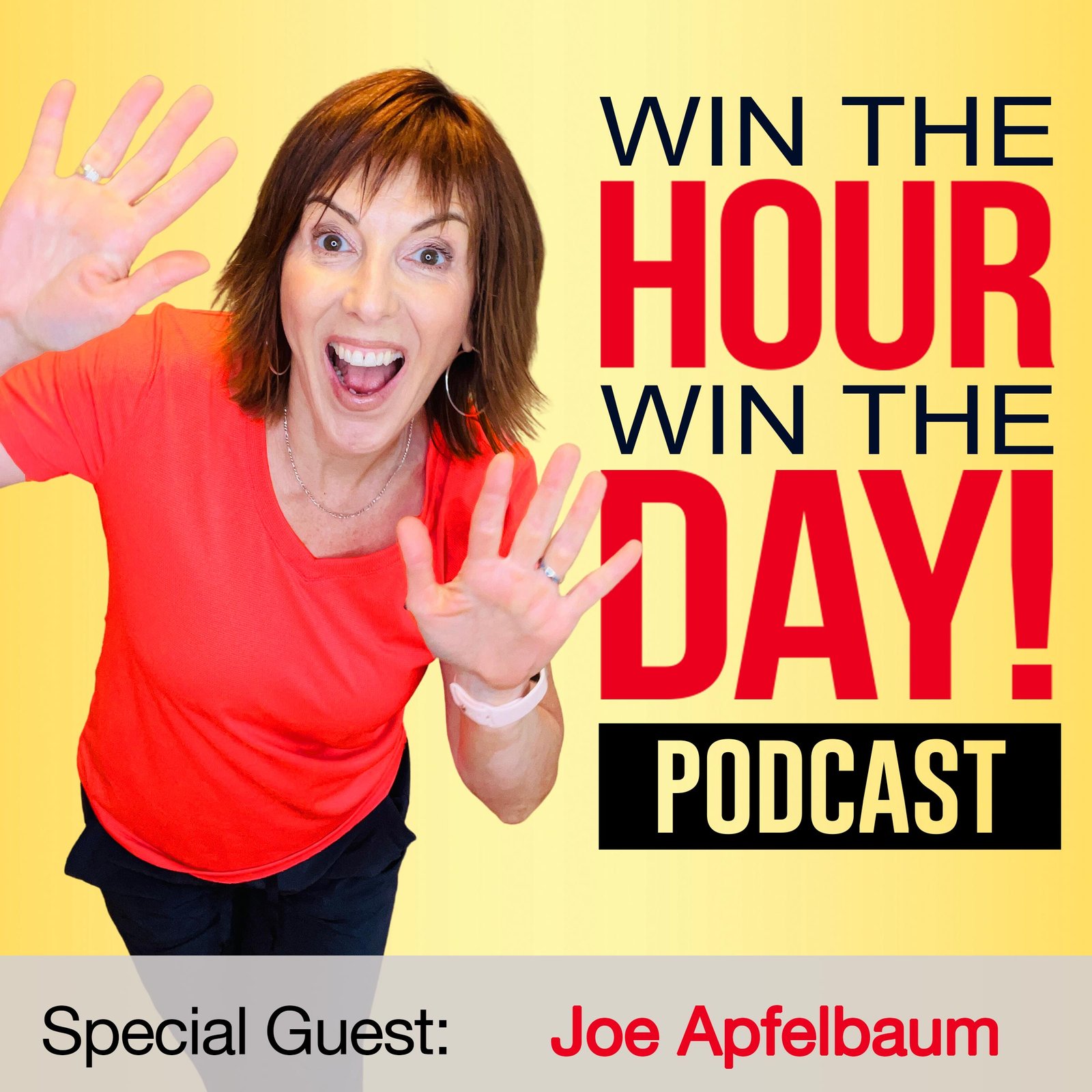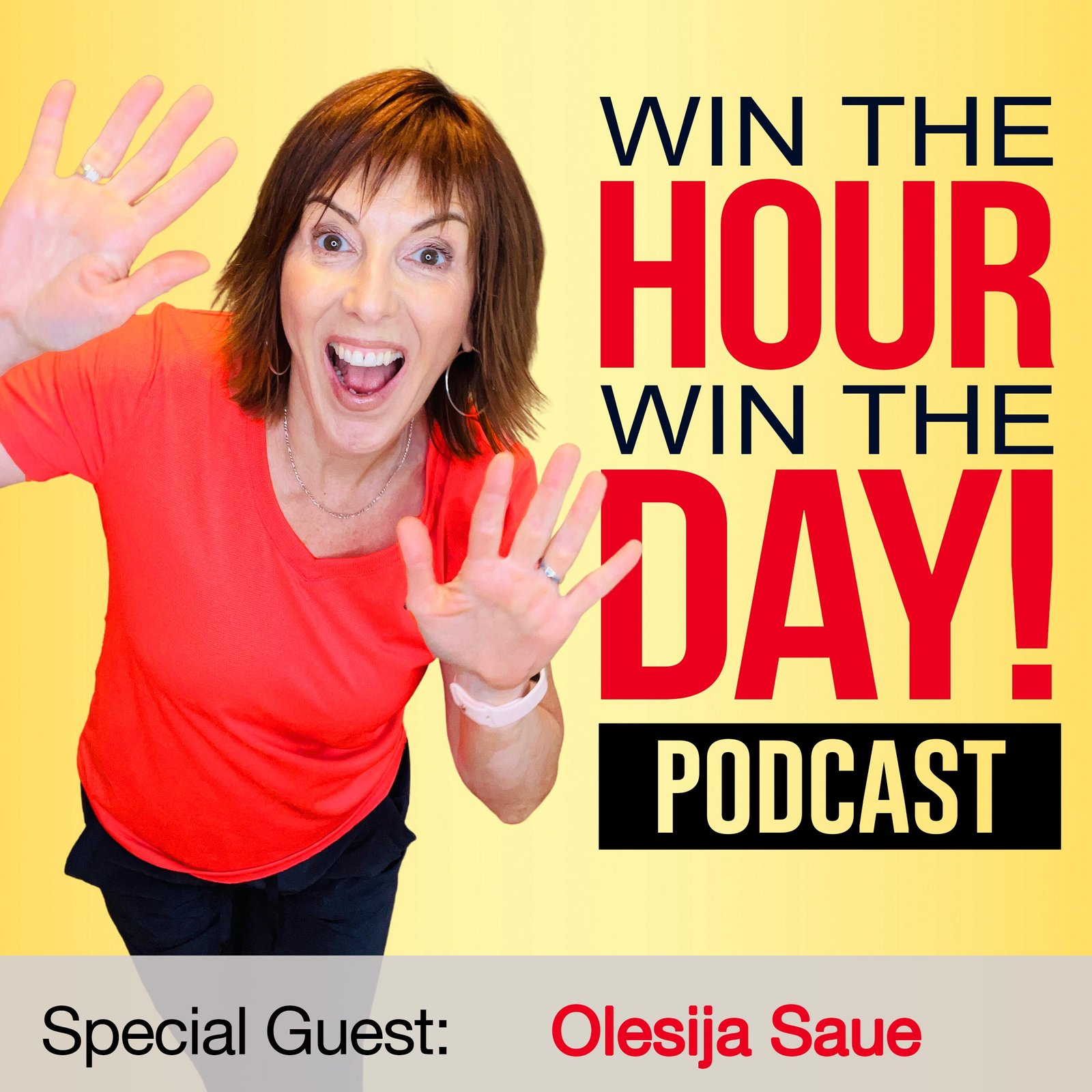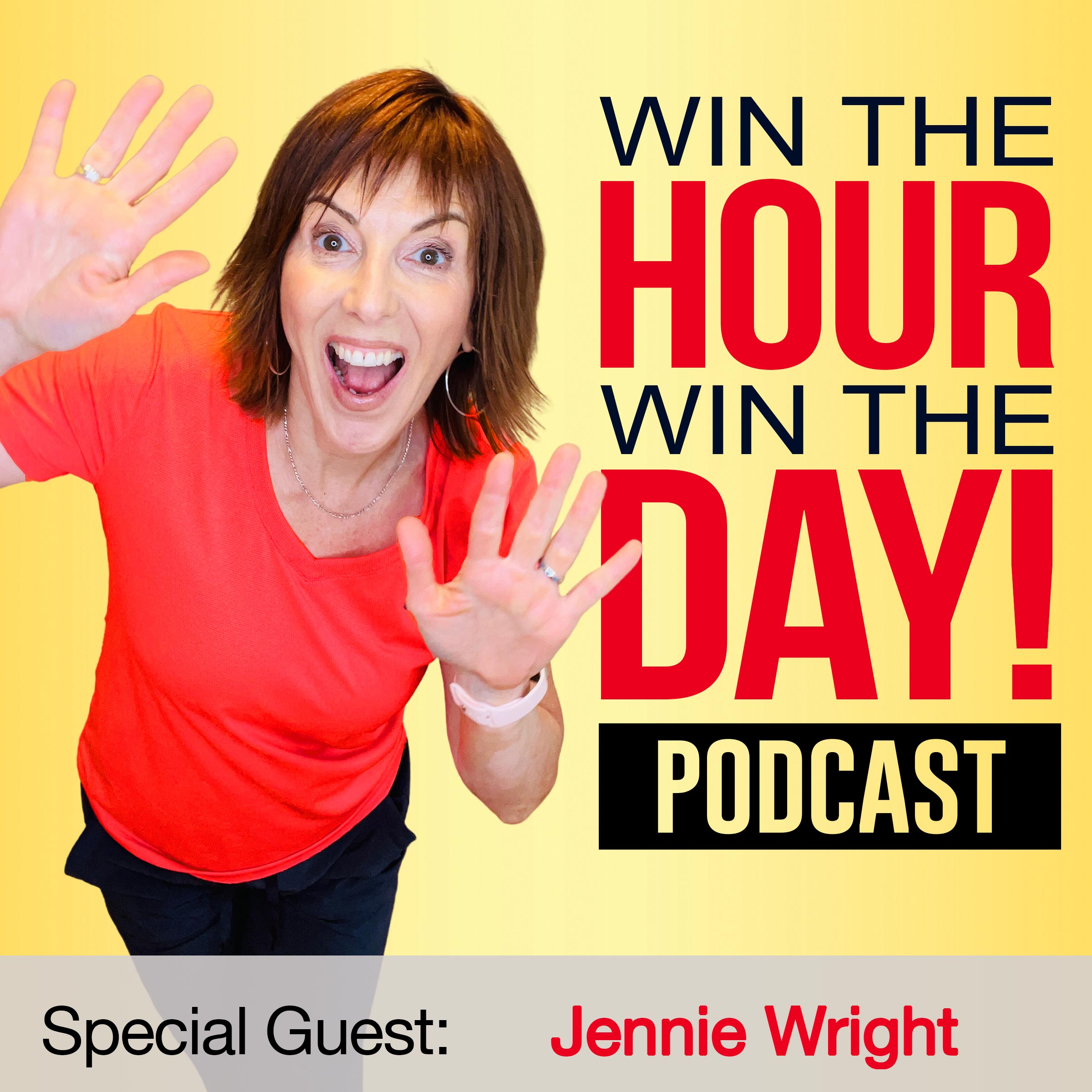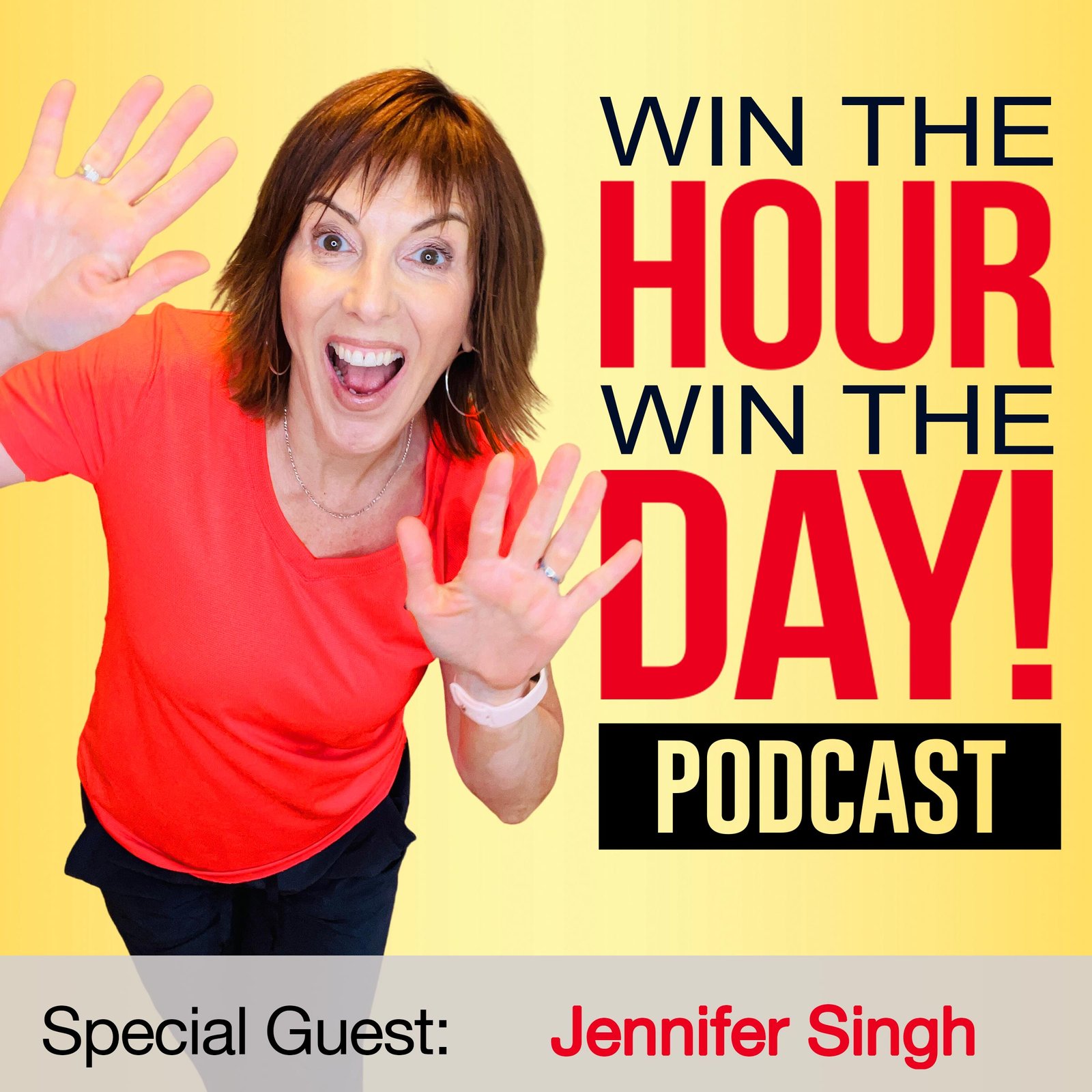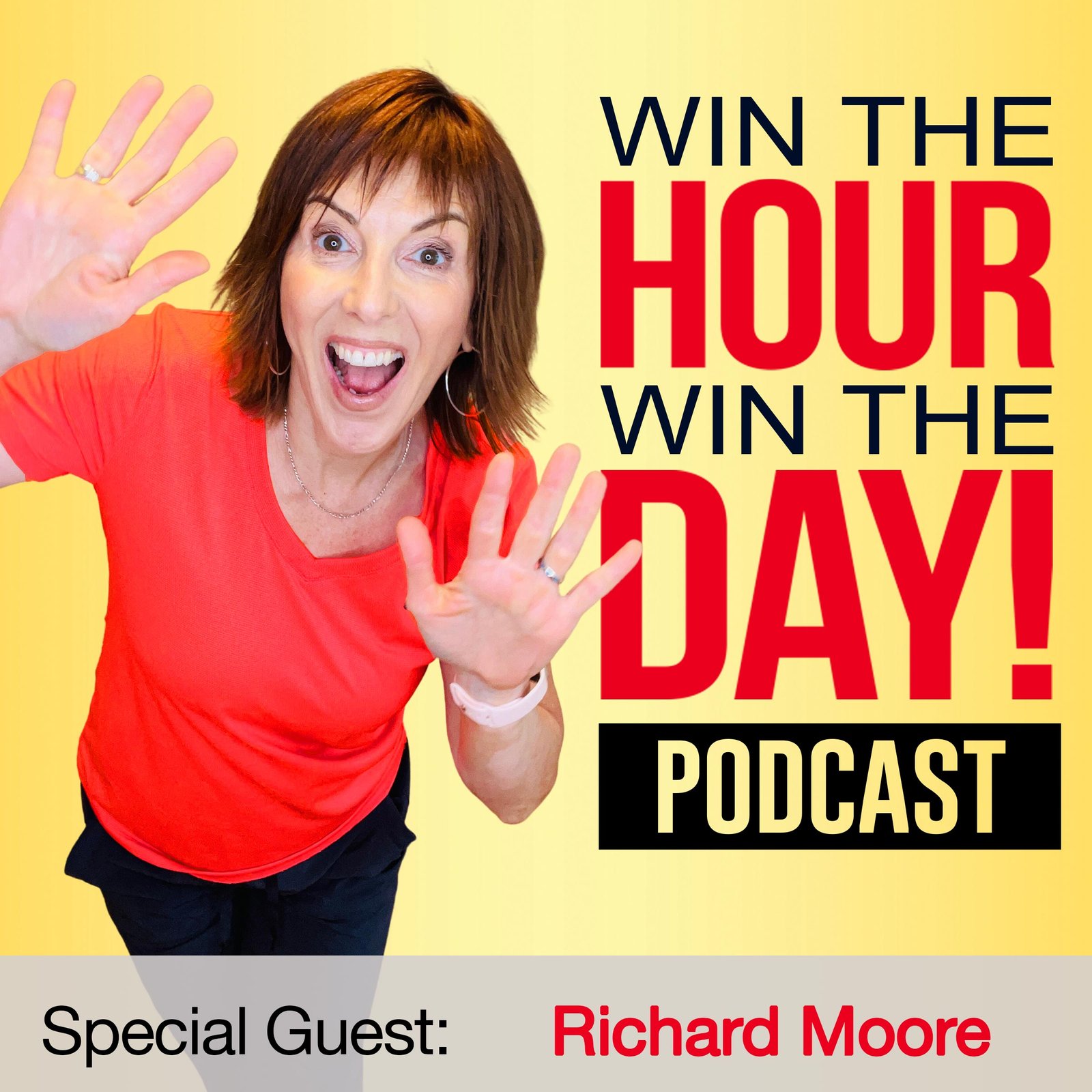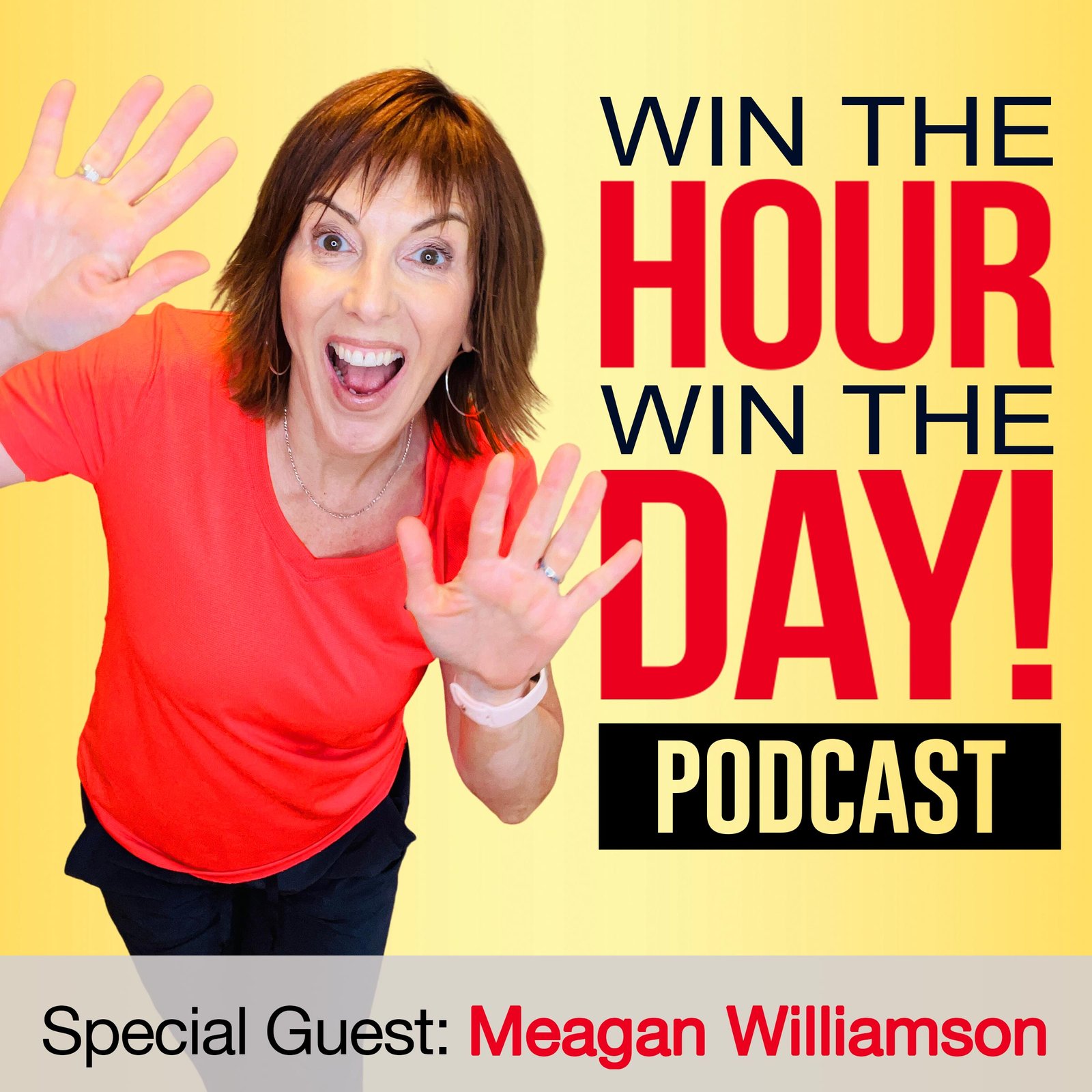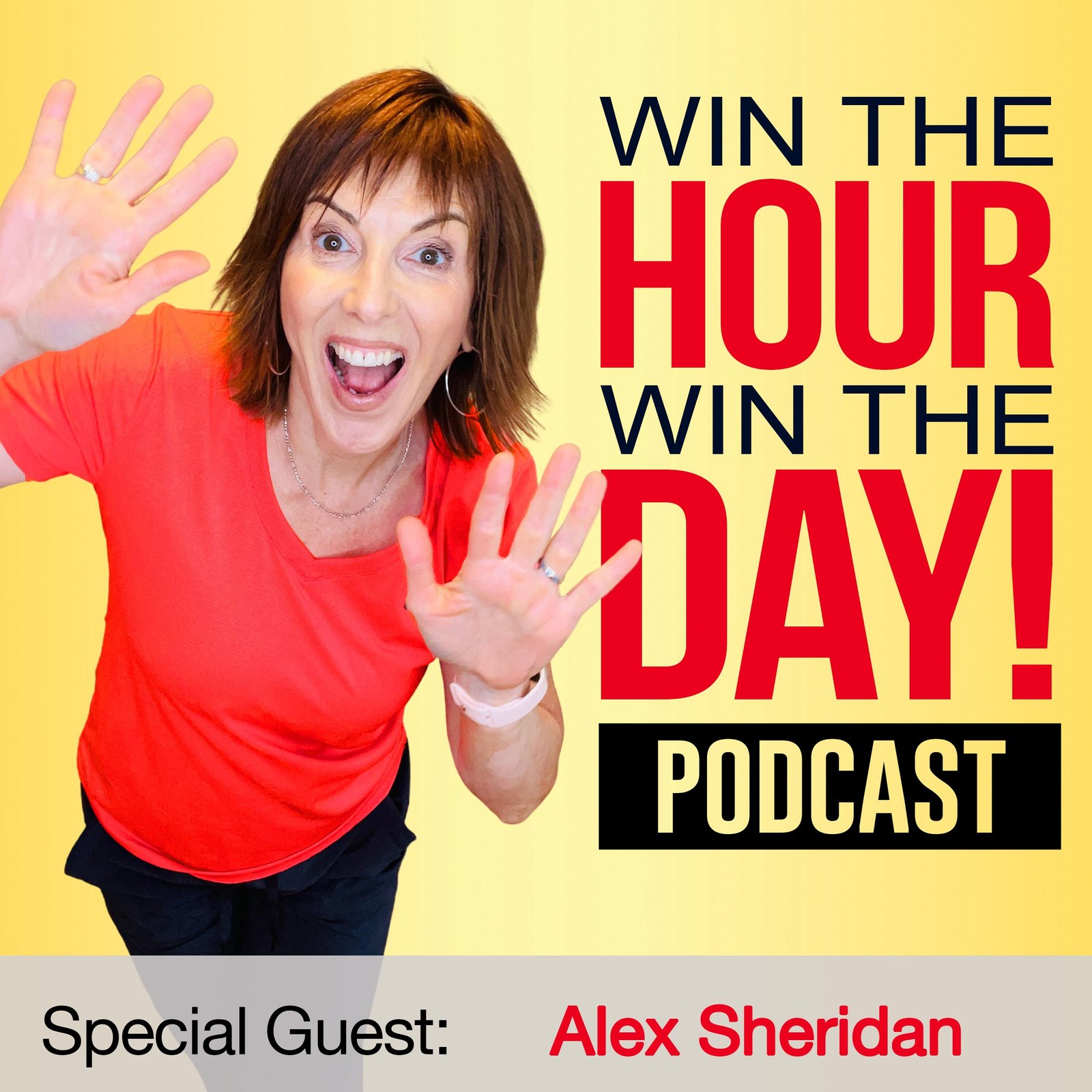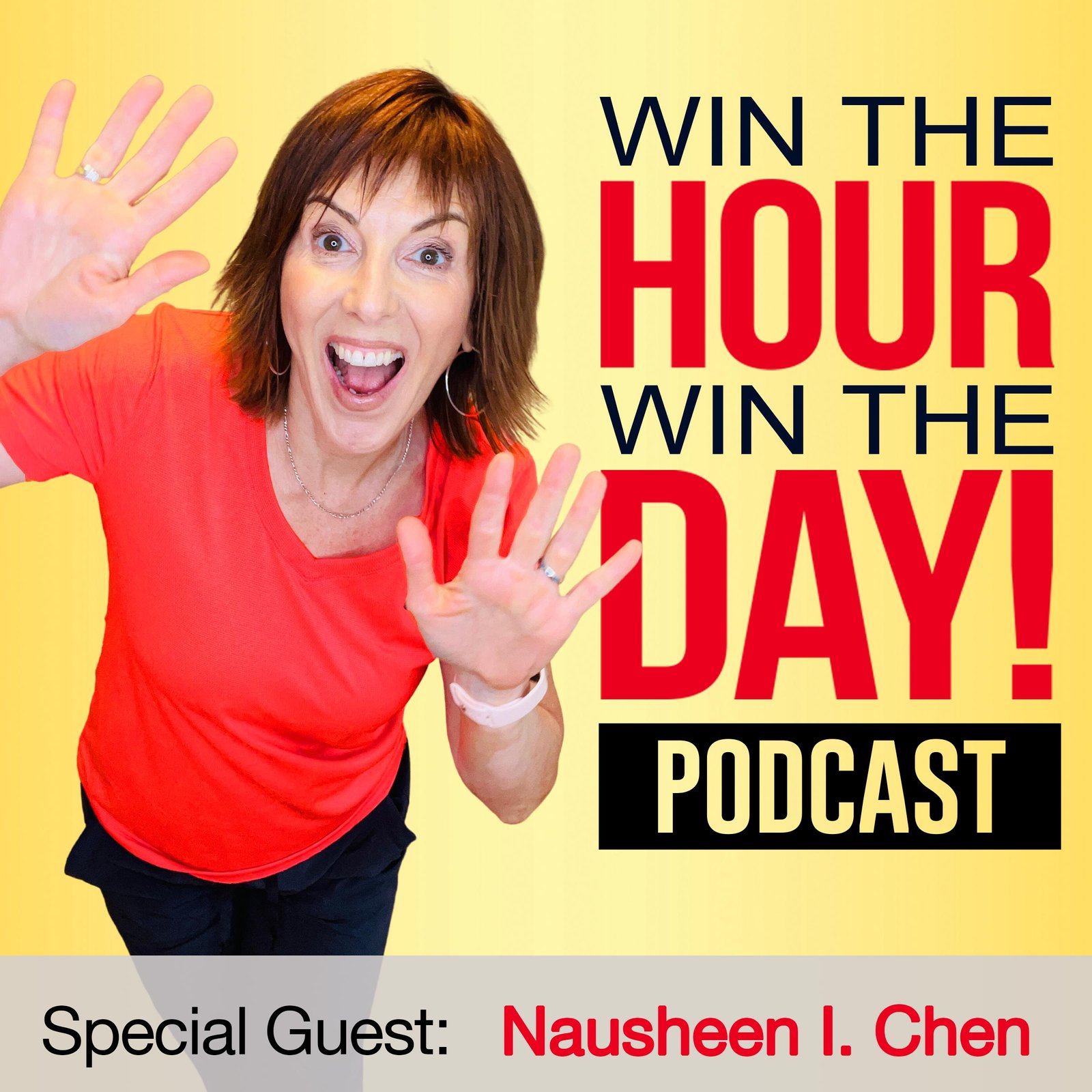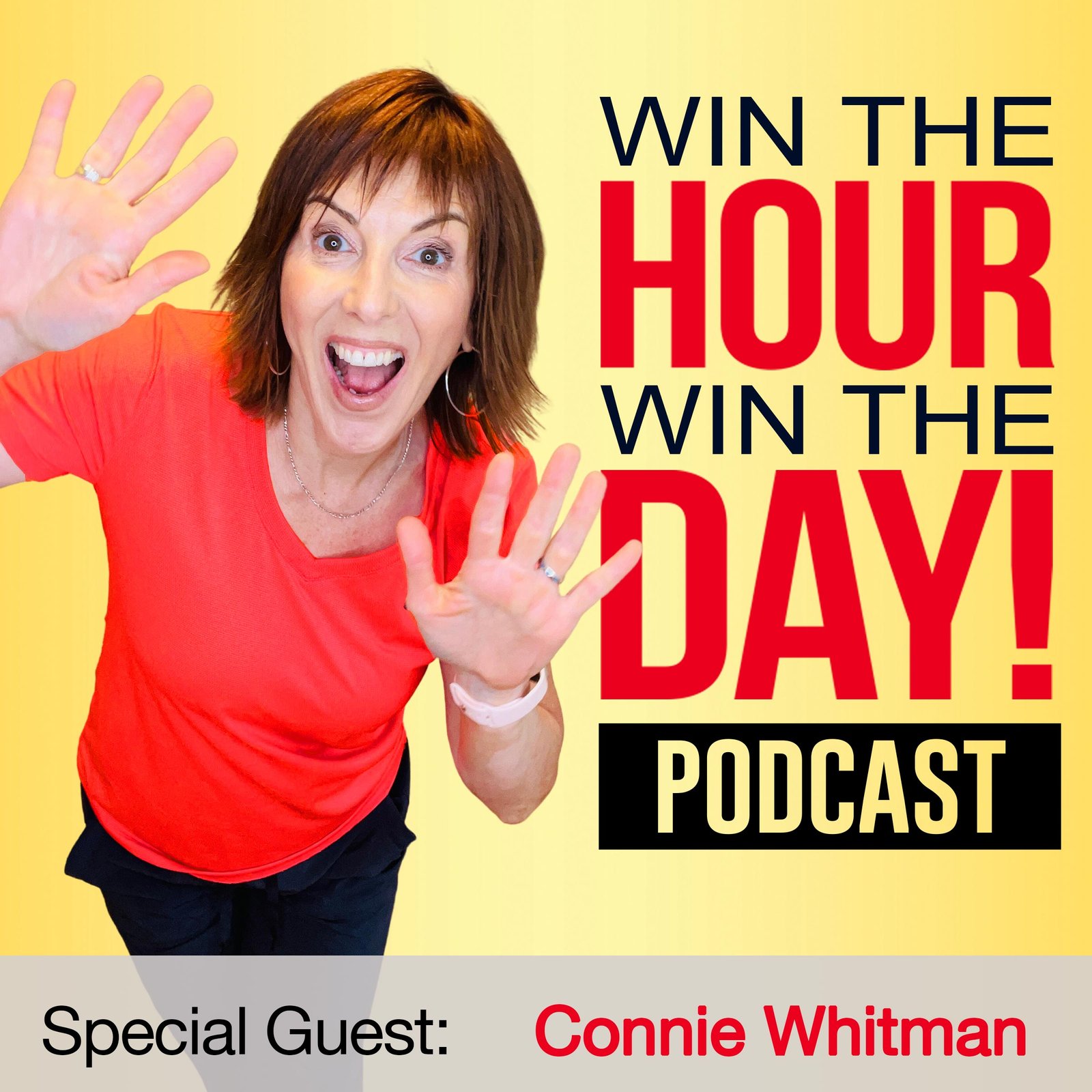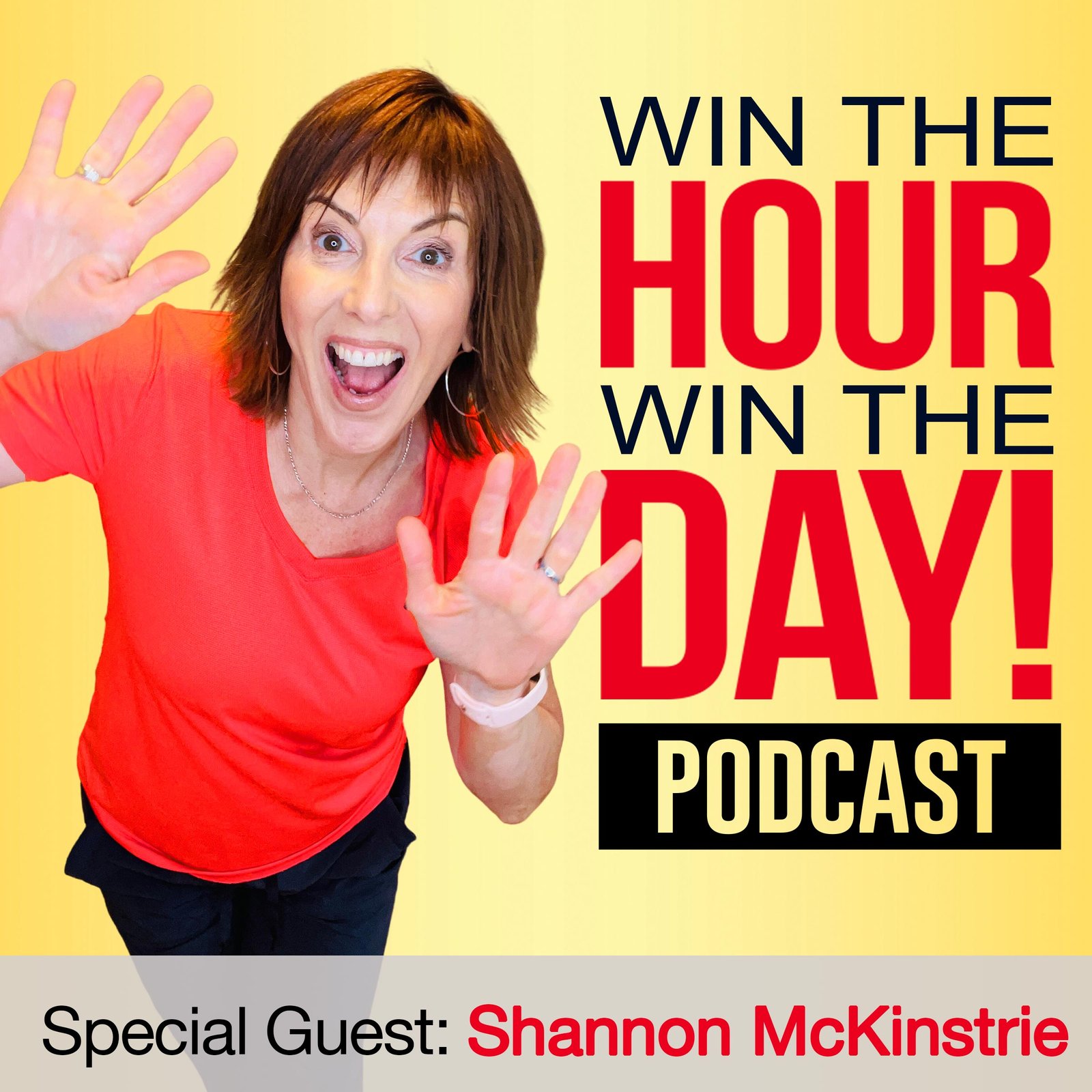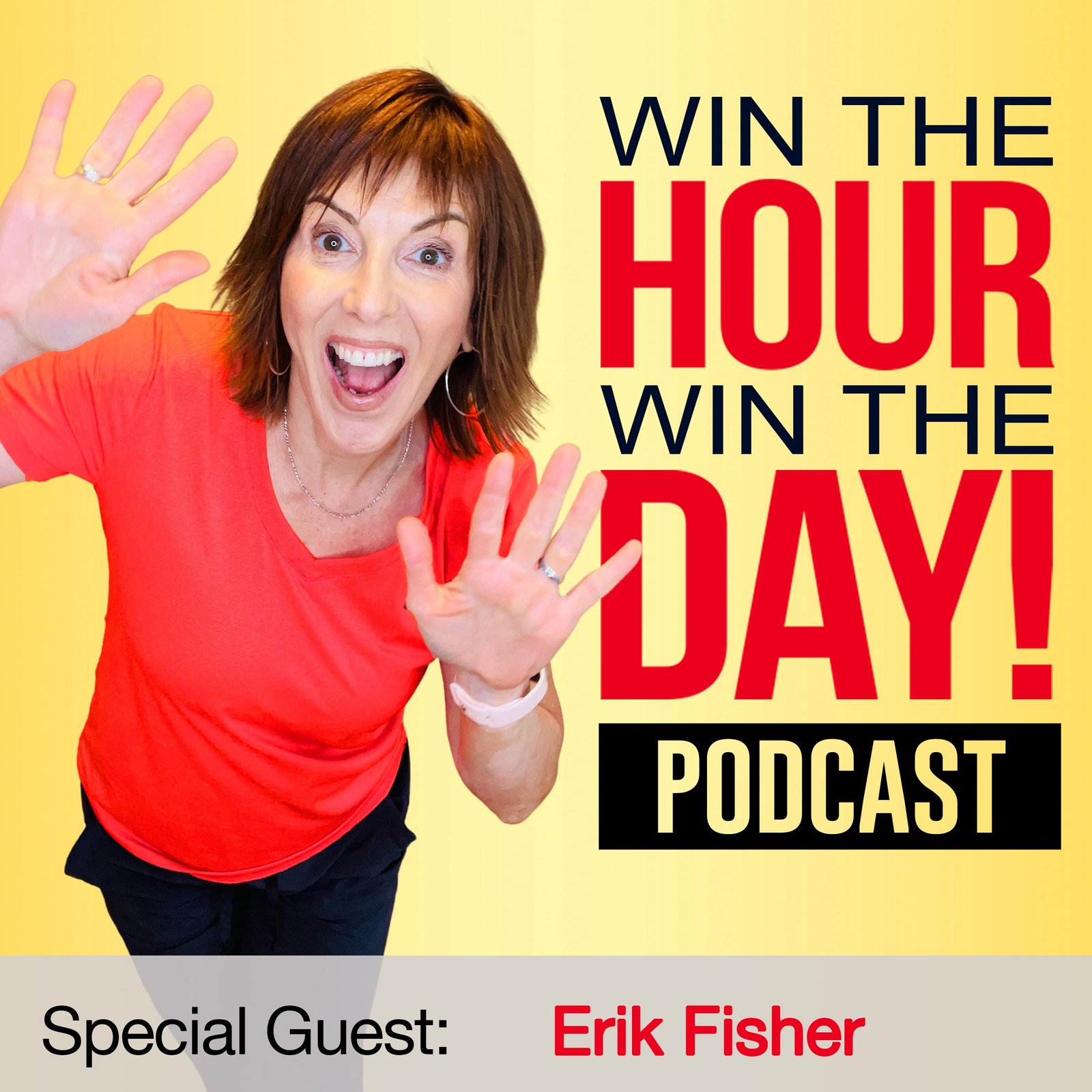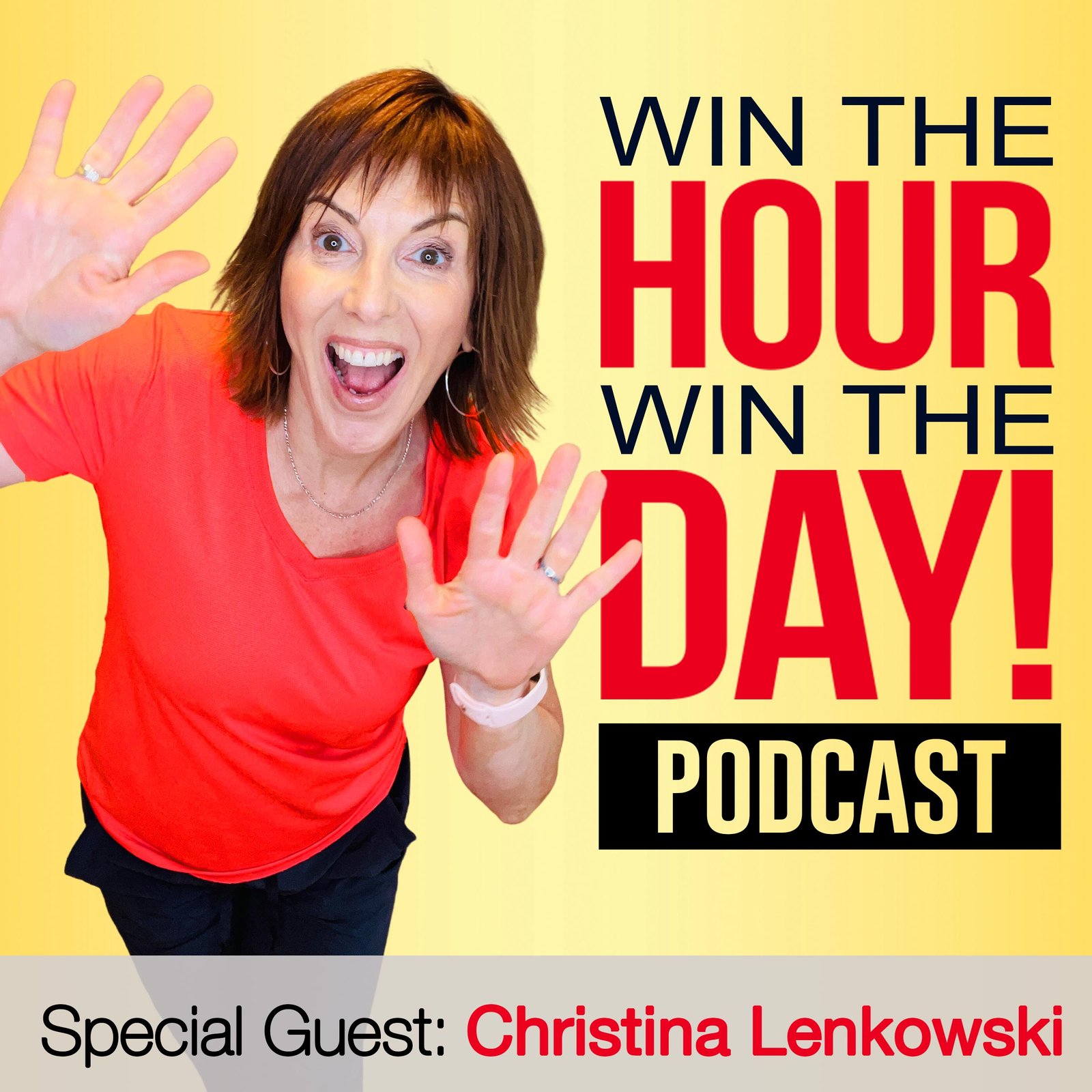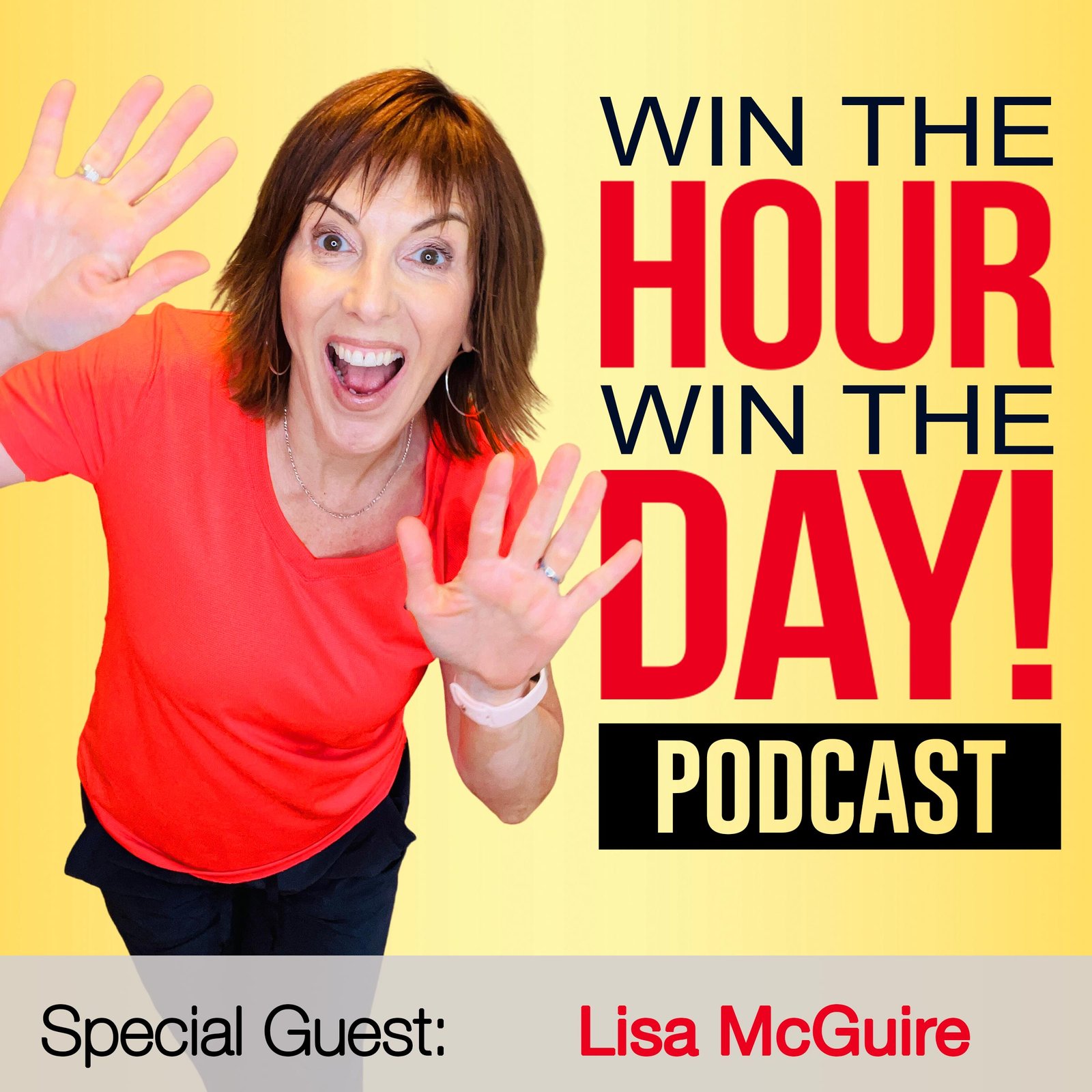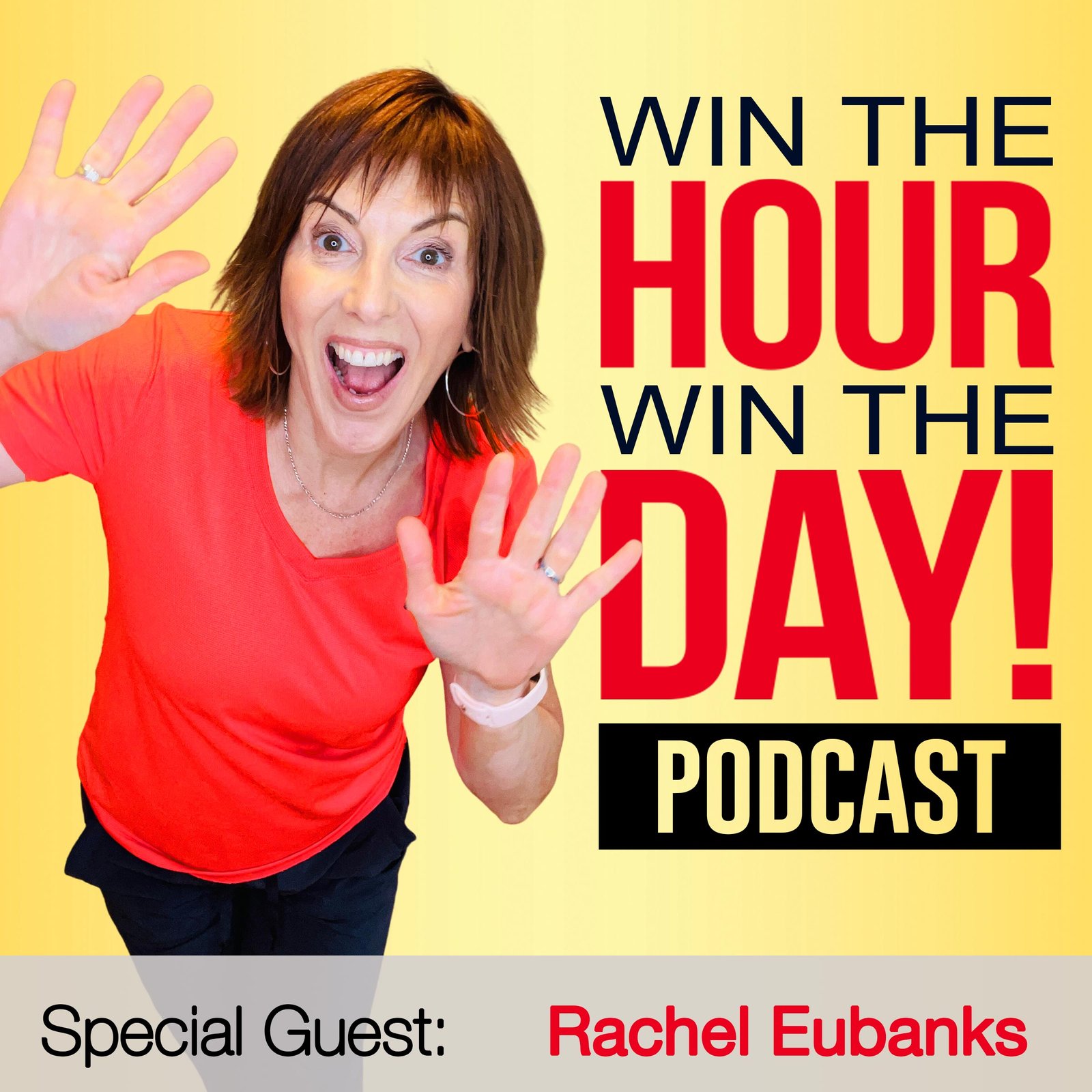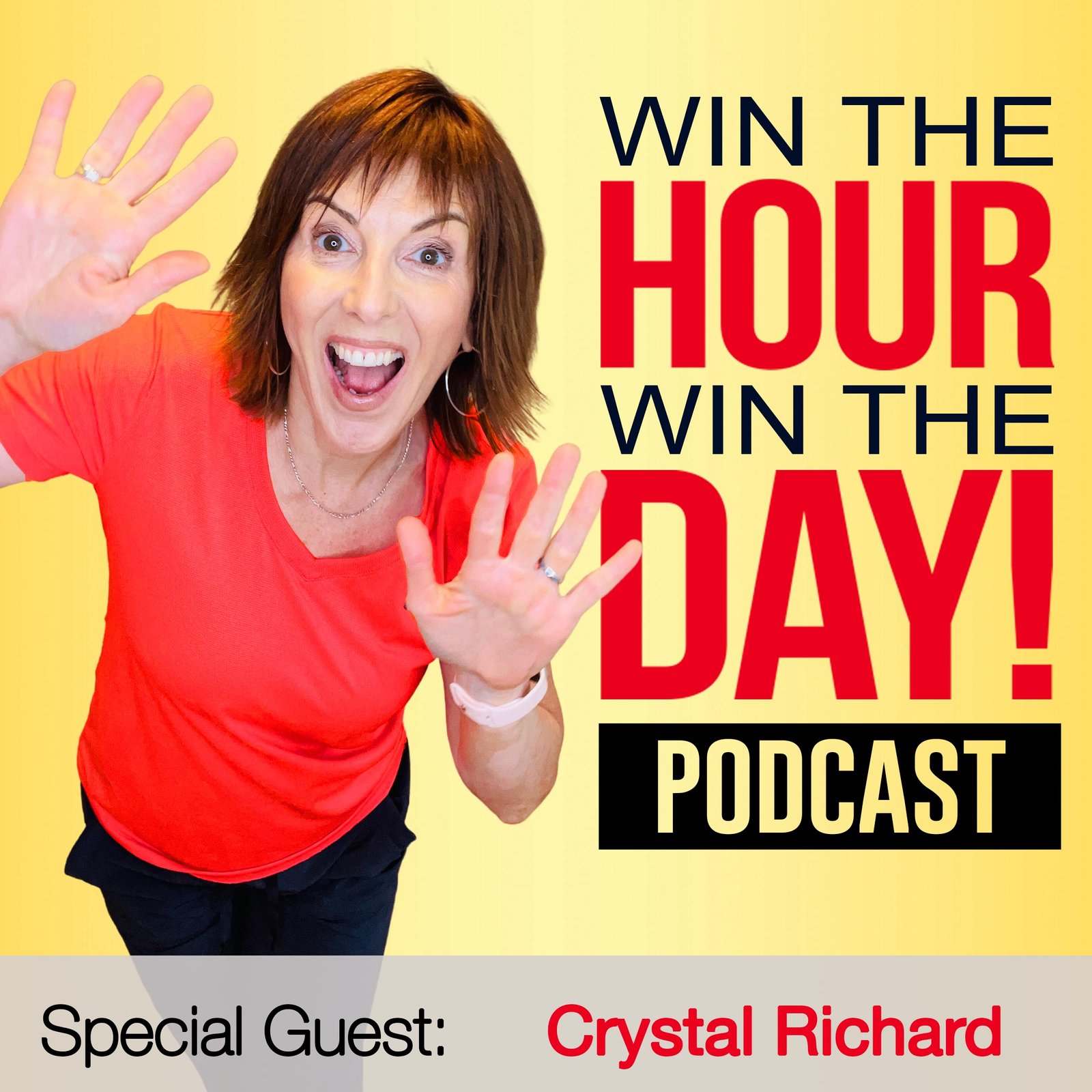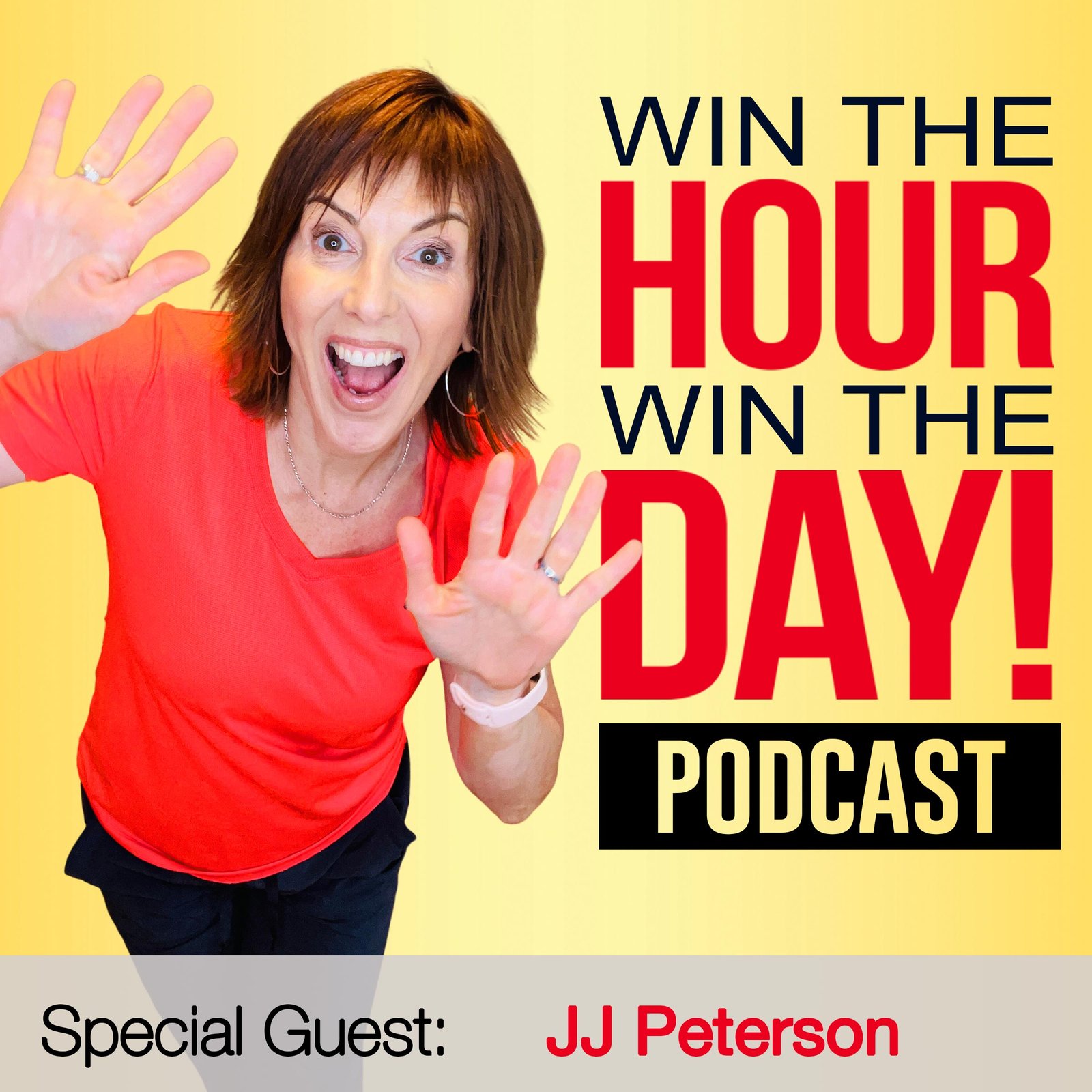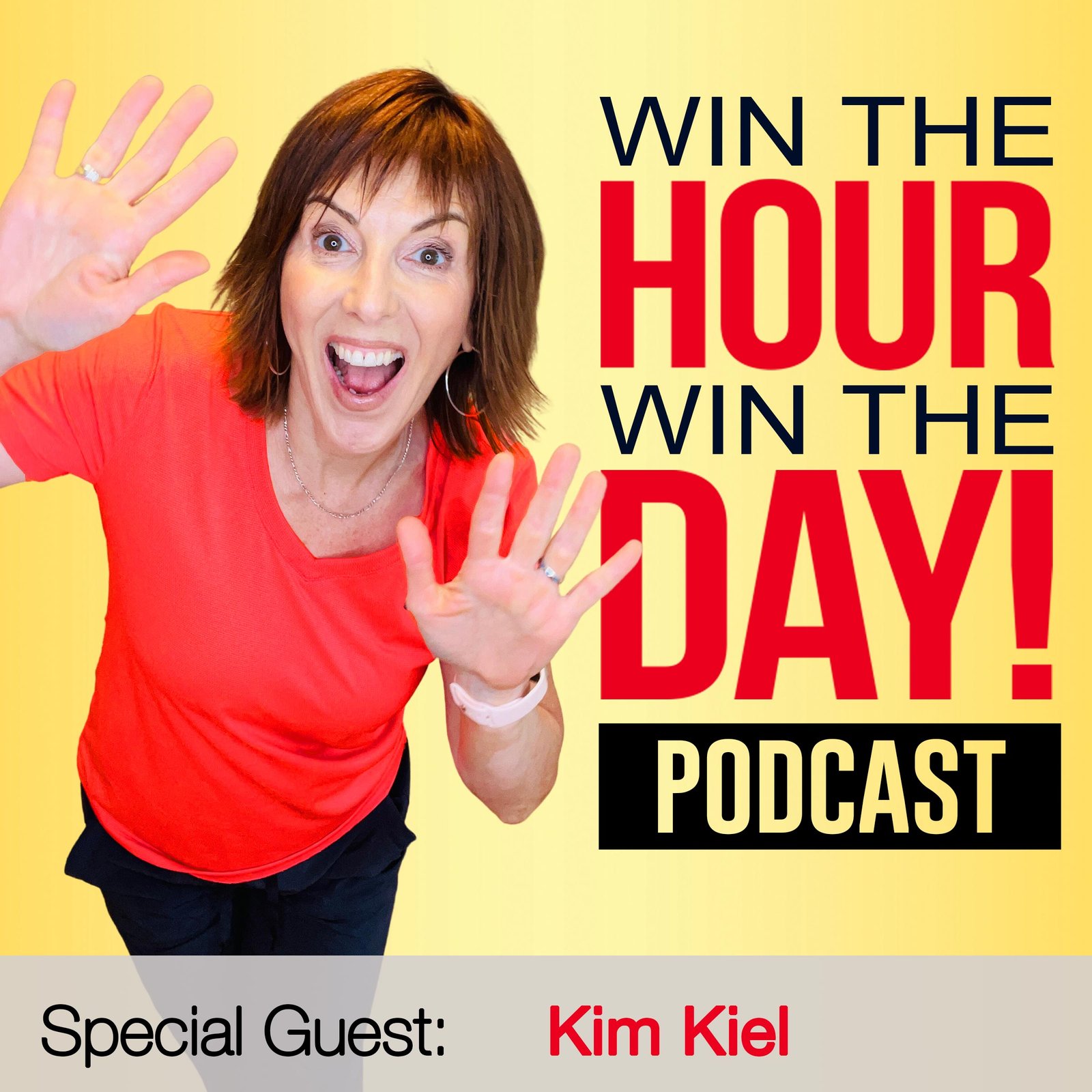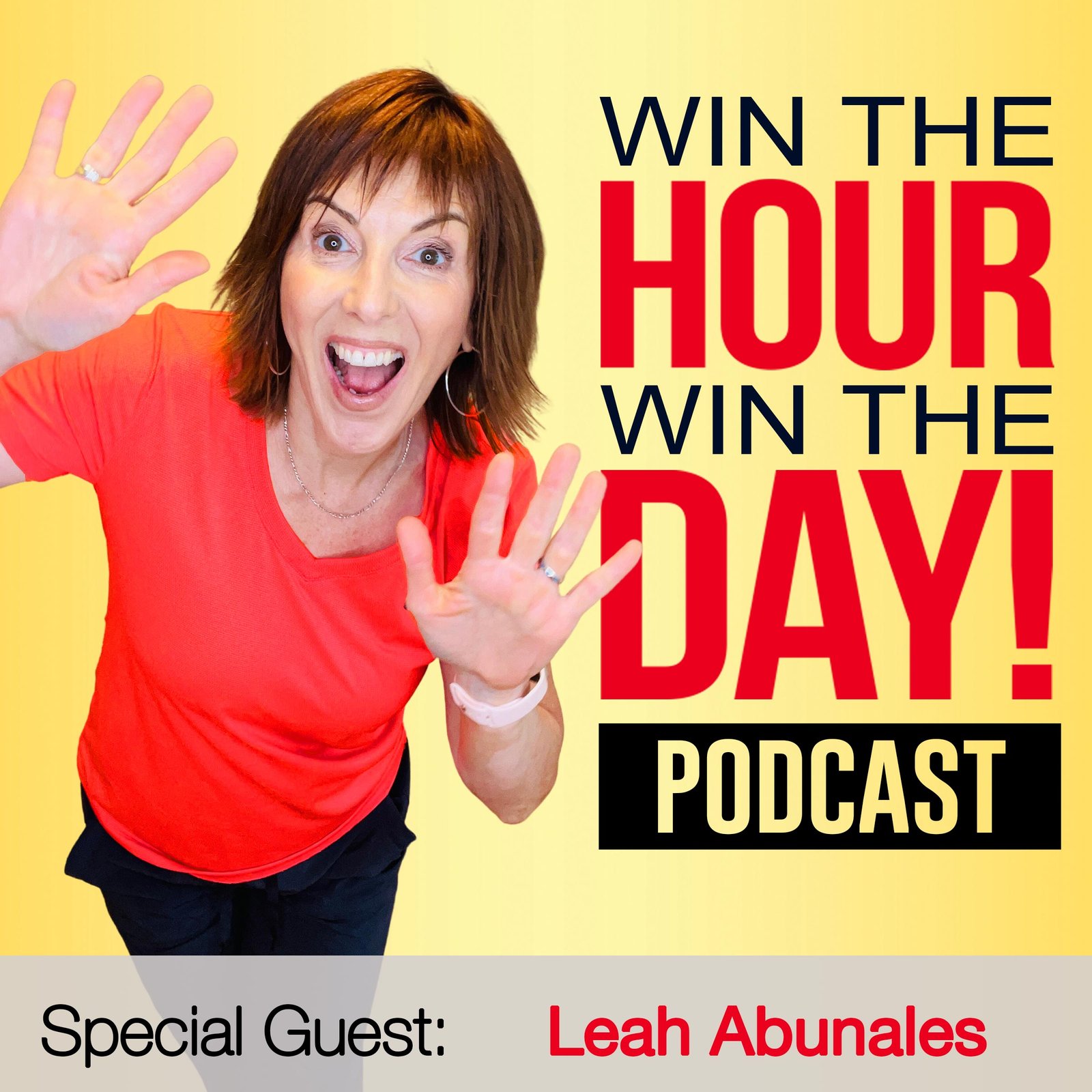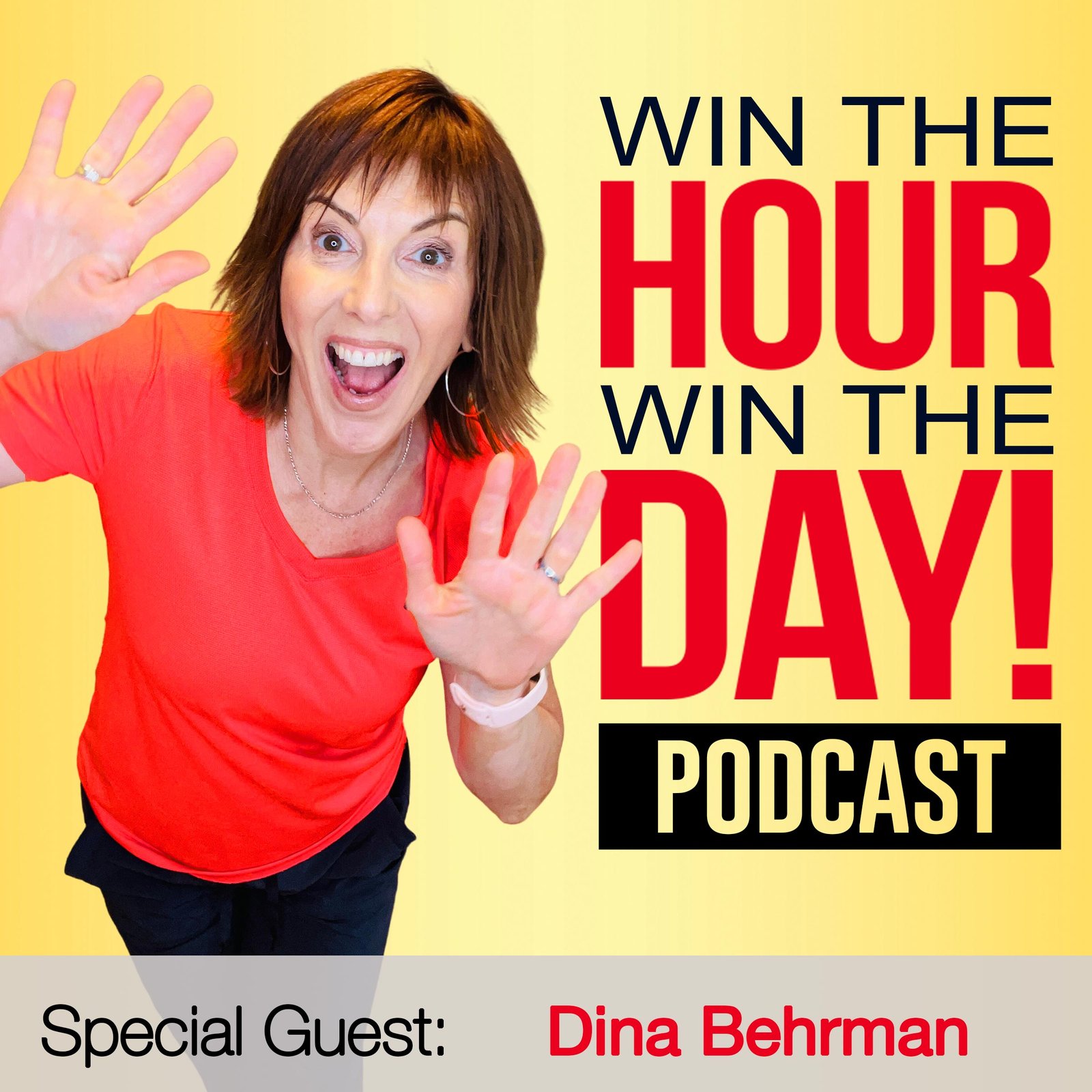Episode Summary This week’s episode of Win The Hour, Win The Day Podcast is...
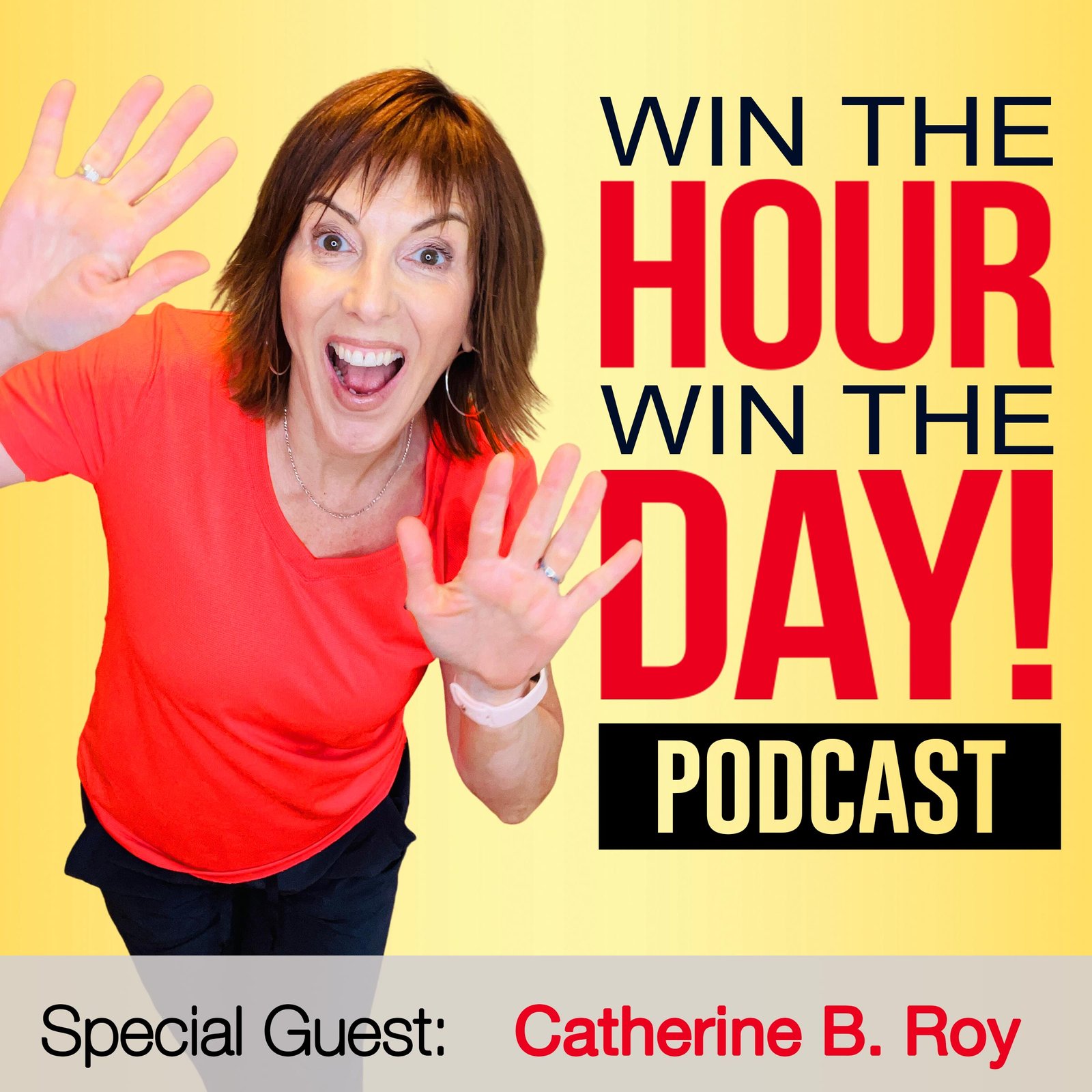
Are You Ready For Your Next Big Win?
Know your entrepreneur personality and I’ll take it from there!
Recent Podcast Episodes
Preventing Burnout with Smart Work Tools! with Kris Ward
Episode Summary This week’s episode of Win The Hour, Win The Day Podcast is...
Master Social Selling: Heidi Medina’s Strategies for Engagement
Episode Summary This week’s episode of Win The Hour, Win The Day Podcast is...
Boost Productivity and Master Storytelling! with AmondaRose Igoe
Episode Summary This week’s episode of Win The Hour, Win The Day Podcast is...
Master Video Marketing: Top Tips for Entrepreneurs with Dan Bennett
Episode Summary This week’s episode of Win The Hour, Win The Day Podcast is...
Boost Your LinkedIn Strategy with AI Tools for Enhanced Productivity! with Joe Apfelbaum
Episode Summary This week’s episode of Win The Hour, Win The Day Podcast is...
Mastering Personal Branding with NLP Techniques! with Olesija Saue
Episode Summary This week’s episode of Win The Hour, Win The Day Podcast is...
Innovative Lead Generation and Email Automation Secrets with Jennie Wright
Episode Summary This week’s episode of Win The Hour, Win The Day Podcast is...
PR Strategies for Diverse Entrepreneurial Impact! with Jennifer Singh
Episode Summary This week’s episode of Win The Hour, Win The Day Podcast is...
Convert More Clients on LinkedIn with Richard Moore
Episode Summary This week’s episode of Win The Hour, Win The Day Podcast is...
Master Business Growth on Pinterest with Meagan Williamson
Episode Summary This week’s episode of Win The Hour, Win The Day Podcast is...
24/7 Sales Boost: Video Marketing Secrets with Alex Sheridan
Episode Summary This week’s episode of Win The Hour, Win The Day Podcast is...
Master Public Speaking Tips with Nausheen Chen!
Episode Summary This week’s episode of Win The Hour, Win The Day Podcast is...
Beating The Burnout With Connie Whitman’s Success Story
Episode Summary This week’s episode of Win The Hour, Win The Day Podcast interviews,...
Craft Your Social Media Content Strategy With Shannon McKinstrie
Episode Summary This week’s episode of Win The Hour, Win The Day Podcast is...
Boost Your Productivity with AI Tools: A Deep Dive with Erik Fisher
Episode Summary This week’s episode of Win The Hour, Win The Day Podcast is...
Boost Visibility: Repurpose Content and Leverage Podcasts With Christina Lenkowski
Episode Summary This week’s episode of Win The Hour, Win The Day Podcast is...
Master Personal Branding & Storytelling with Lisa McGuire
Episode Summary This week’s episode of Win The Hour, Win The Day Podcast is...
Scale Your Business: Optimizing Virtual Assistant Services with Kris Ward & Rachel Eubanks
Episode Summary This week’s episode of Win The Hour, Win The Day Podcast is...
Affordable PR Mastery: Crystal Richard Unveils Modern Techniques
Episode Summary This week’s episode of Win The Hour, Win The Day Podcast is...
Mastering Business Storytelling with JJ Peterson’s Guide
Episode Summary This week’s episode of Win The Hour, Win The Day Podcast is...
Revamp Your About Page: Guide to Personal Branding
Episode Summary This week’s episode of Win The Hour, Win The Day Podcast is...
LinkedIn Mastery and Video Marketing Secrets with Alex Sheridan
Episode Summary This week’s episode of Win The Hour, Win The Day Podcast interviews,...
The Systems and Processes Playbook: Insider Secrets to Streamlining Your Small Business with Leah Abunales
Episode Summary This week’s episode of Win The Hour, Win The Day Podcast interviews,...
Getting Noticed: PR Strategies with Dina Behrman
Episode Summary This week’s episode of Win The Hour, Win The Day Podcast interviews,...
Boost Business on LinkedIn with Catherine B. Roy’s Strategies
Episode Summary
This week’s episode of Win The Hour, Win The Day Podcast is sponsored by Win The Hour, Win The Day’s Signature Coaching Program the Winners Circle. Kris Ward who helps entrepreneurs to stop working so hard interviews, Catherine B. Roy.
Master LinkedIn with Catherine B. Roy, the LinkedIn Wonder Woman…
and turn your profile into a client magnet.
In this episode, you’ll discover:
-How Catherine tripled her business using LinkedIn.
-The secret power of LinkedIn as a search engine for business.
-Simple strategies to increase your visibility and attract more clients.
Get the full potential of LinkedIn for your business with Catherine B. Roy’s expert insights.
Don’t miss this chance to elevate your LinkedIn presence!
Power Personality Quiz! http://winbacktimequiz.com/
Win The Hour, Win The Day! www.winthehourwintheday.com
Podcast: Win The Hour, Win The Day Podcast
Facebook: https://www.facebook.com/winthehourwintheday/
LinkedIn: https://www.linkedin.com/company/win-the-hour-win-the-day-podcast
Release your full potential and achieve more in less time
Don’t miss out on these valuable insights!
You can find Catherine B. Roy at:
LinkedIn: https://www.linkedin.com/in/catherinebroy/
Win The Hour Win The Day
https://winthehourwintheday.com
Catherine B. Roy Podcast Transcription
[00:00:00] Kris Ward: Hey, everyone. Welcome to another episode of Win The Hour, Win The Day I am your host, Kris Ward. And today in the house, we have Catherine B. Roy. Listen, I have been following her for quite some time, but if you don’t know her, she is a fantastic online business coach, but that doesn’t really describe it.
[00:00:16] People refer to her as like the LinkedIn Wonder Woman. That is a name her clients have been given her. And Oh, I can’t wait to dive into this because she is going to blow the lid off LinkedIn. I’m going to tell you why. Let’s get to it. Catherine, welcome to the show.
[00:00:31] Catherine Roy: Thank you so much for having me. And thank you for this lovely introduction.
[00:00:36] Kris Ward: Okay, Catherine. So why don’t you start right from the beginning and tell us what makes you different about LinkedIn and why we’re going to learn so much more from you in a different capacity than we ever have before?
[00:00:48] Catherine Roy: Kris, I was a programmer for 15 years. I actually wrote a lot of lines of codes in huge corporations.
[00:00:55] And I see this social media and web platforms a little bit differently because I understand how everything functions behind the scenes. But also I had the chance to be in a six weeks program with LinkedIn editorial team from UK and on several sessions with LinkedIn editorial team from USA. So I’m so excited that I can share so many wonderful things about the platform, which actually changed my life and my business because I tripled my business twice during the pandemics.
[00:01:23] And this is the moment when I left corporation and started growing my own business on my own.
[00:01:28] Kris Ward: You had me at hello, so let’s dive in. Okay. Where do you want to start sharing? What should we talk about?
[00:01:34] Catherine Roy: I just went to a conference in Spain in 2019, I believe. And then I heard about LinkedIn from CEOs from very large companies.
[00:01:43] And I was very curious, LinkedIn for me was just a CV, right? I have it for so many years. And, but the truth to be told, Microsoft acquired LinkedIn in 2017. And this is how everything started to change because now at this moment, when we speak, I am free to say that LinkedIn is the most powerful search engine in business space.
[00:02:05] There is none other social media or online resource, which can give you so much information about 80 million companies in the world and decision makers who are over there. So four out of five people on LinkedIn are decision makers. Opportunities are unlimited and taking the fact that. Microsoft actually invested in OpenAI several billion dollars when they were just a startup.
[00:02:32] Microsoft owns LinkedIn, so they’re now incorporating AI a little bit when we are writing a connection request, for example. But my prediction is that probably they will be the best place where actually the algorithm will suggest us with who we need to connect and how we need to connect, practically grow our network.
[00:02:55] And our network is our net worth. And that’s the most important thing in business, right?
[00:03:00] Kris Ward: A hundred percent. Now, I hope you take this as a compliment, but with your brilliance, And your accent, I feel like I’m in a movie about how LinkedIn is going to take over the world. Those movies, they tell you what the accent of this is what we can do.
[00:03:13] We can have world domination. And I’m like, all right, I’m really listening because I was like, Catherine, you and LinkedIn are taking over the world. Okay. All right. You got my attention. So LinkedIn, I, we do, we have seen a big change in the, say the last year where it’s warmed up. It’s not so dry. It’s not so stuffy.
[00:03:32] I’m using the video more in the connections, and then DMing that they’ve got the video option there. I always use the audio. There’s a whole bunch of things I use. So what do you feel that most of us, I know you have a fantastic course and stuff like that. What do you feel that most of us miss?
[00:03:47] Where are we just totally just, we’re not looking at it. We should?
[00:03:51] Catherine Roy: There are several things. First, we need to look at the profile as our not landing pages. Most of the coaches say, because landing pages don’t have distractions. LinkedIn page has distractions. So it’s more like a shop window and think about using keywords and LinkedIn as powerful search engines.
[00:04:10] So SEO is one of the most important thing when we build our profile, because if we have a creator mode, for example, which I believe everyone now has, if they are creators on LinkedIn, they give us like five hashtags, which we can use, right? Those hashtags are keywords. Every second word we use in our headline is a keyword.
[00:04:32] Every single word we use in our about section is a keyword. So if you check my profile, you will see that I intentionally repeat the same keywords because I want algorithm to remember and recognize everyone who is searching for a business coach or coach, consultant, entrepreneur, who are people who I’m serving, they will find me.
[00:04:53] Kris Ward: That’s okay. Let me jump in there for a second. This may be, I’m not a programmer. I can’t even imagine getting up and living a life and my job. I would end up, I think I’d sooner go to jail than try to be a programmer. They would, I can’t do it. So there’s no so you’re smarter than all of us there.
[00:05:08] You’re smarter than all of us for sure in this room. So this may be a silly question is, are the keywords like we, most of us have getting a better master of our keywords, say with Google and on our website. And so sometimes I’m wondering, are those keywords the same as LinkedIn? If these keywords resonate well for me in Google, are they going to resonate well for me on LinkedIn or do I have to find the new keywords there?
[00:05:32] Catherine Roy: For LinkedIn, it’s very important that we use the keywords that we believe someone will search and that someone is our target group and that they find us. So for example, when you see my headline, I use a model, who am I, what I’m specializing for, like a classic boss bio. And I say I’m a business coach specializing in helping coaches, consultants, entrepreneurs, small business owners.
[00:05:58] So whoever search for coach, consultant, entrepreneur, small business owner will again stumble upon me. This is why you are seeing me everywhere.
[00:06:08] Kris Ward: Okay, that’s a huge
[00:06:11] Catherine Roy: You know, you hold me and… I hold on me.
[00:06:14] Kris Ward: Okay, hold on. That’s a really good point. I’m so Oh my gosh. Hold on. Stop the truck. So I never refer to myself as a business coach for a whole bunch of reasons, because in my mind, a business coach is cheering you on from the side and we’re so much more hands on.
[00:06:30] We really, in fact, a lot of business coaches give you homework and my clients say it’s so interesting because every week they have less and less on their plate. Where mostly coaches give you homework. I don’t see myself as a business coach, but you’re right. Nowhere on my profile, does it say business coach?
[00:06:45] So somebody could be king and business coach. I’m going right to virtual assistant, burnout, scale your business, which are the outcomes, but I’m missing the boat on business coaches. The most obvious, I guess it’s I don’t know. I’m not referring to myself. So that’s a keyword that I would be missing on.
[00:07:02] You’re right when people are doing that on LinkedIn. So there’s some obvious stuff too, that you’re bringing up.
[00:07:07] Catherine Roy: It was very obvious, but people usually miss the most obvious things. And, if you don’t use it in the headline, it’s good to have it in about section and about section is all about our clients.
[00:07:19] So this is a completely important shift because LinkedIn wants us to serve someone. So I’m not starting with my bio because no one is interesting to know anything about me. They want to know how I can help them. So again, I’m repeating, if you are a coach, consultant, small business owner, and you’re looking for, and then I, place my value proposition, then give me a call.
[00:07:42] There is a call to action. And then I talk about myself. Now a very important thing every experience which we have on a profile isn’t just a working experience anymore. It doesn’t say anymore working experience, it says experience. If I’m a member of a Forbes coaching console, it is in my experience.
[00:08:01] Why? Because I want everyone who is searching for Forbes to find me. If I did a training in Microsoft, then I will set that in my experience because I want whoever search for Microsoft again to find me. And I will use the names of these companies and most probably the names of the companies my client engaged in my About section because people are searching for companies.
[00:08:22] So again, they can find me.
[00:08:24] Kris Ward: Can I jump in? So for many of us who don’t get to work for Forbes and don’t get to be hired by Microsoft because we’re, our names are not Catherine B. Roy. Could we then, so I did right now, I, we did a blog and we ranked above Forbes. For at least two weeks an hour underneath Forbes on this one blog, we did, we’ve done that.
[00:08:43] Or when I have had stuff in the press, of higher levels, whatever NBC news or something, they captured one of my articles or press release. Can I put those things in there? Is that stuffing it or that’s fine? Okay.
[00:08:56] Catherine Roy: Of course. Or if you don’t feel like that’s an experience, there is an option to set it as a project or something that you worked on because it…
[00:09:05] it doesn’t matter actually where it is on the profile, it’s important it’s there.
[00:09:10] Kris Ward: So now, but somebody’s not going to be keying in Forbes and end up going, Oh, I was going to go with Forbes, but I found Kris. So how does that help me in my profile?
[00:09:18] Catherine Roy: Because when they search for Forbes, they will see who engaged and they are going to see you.
[00:09:24] An algorithm will remember the search results they got and then start showing your your content to them on their newsfeed. So the whole idea is to get your content in front of their eyes.
[00:09:38] Kris Ward: Oh my God, my head is exploding. I was like, okay, because I think too many of us get too linear. It’s okay, so what I’m thinking is somebody is not going to key in Forbes and look for Forbes and then go, wow, I didn’t get Forbes, but I’ll take Kris.
[00:09:52] She’s the second best. So that doesn’t make sense to me. But when you said, oh, now the algorithm knows he was looking for Forbes and Kris is on that list. So now it’ll start feeding my post in front of them. So maybe they don’t go for Kris today, but they’ll go for Kris. A month from now or whatever. So it changes the algorithm. Oh, this is interesting. Oh my gosh. Okay. Continue.
[00:10:14] Catherine Roy: It’s very cool. Even when you create something, when it’s just the post, there is an option to set that post to be more visible because hashtags are keywords. So if you use three hashtags, LinkedIn will, and this is a kind of a trick, LinkedIn will take that three, those three hashtags and include them in the URL of the post. If your profile is public, the URL of the post will have some kind of metacode, let’s say that way, and these three hashtags. So everyone who engages with that post gives the ping to the search engine and also to Google because Google is a public search engine and they are connected.
[00:11:01] And this is how I ranked on Google with more than 50 million search results.
[00:11:07] Kris Ward: Okay. But what if we all go, all right, great, but my name’s not Catherine B. Roy. See, it really sounds impressive. We keep throwing the B in, right? So my name’s not Catherine B. Roy. My engagement is low. So I’m doing that. I’m using hashtags and everything’s beautiful when you got a lot of engagement, it’s like having good credit.
[00:11:25] You don’t need money. You, but when you have bad credit, you really need money. So what do we do? Can we help with the engagement?
[00:11:32] Catherine Roy: We all were at the starting point at one moment. I became publicly recognized because I intentionally used my name as a backlink to every public source. And for example, on LinkedIn, I have my own personal branding hashtag.
[00:11:48] So every post will include hashtag Catherine B. Roy. Okay. And this is, add to every link that is created by LinkedIn. So whenever someone engages will ping my name and then I will get more visibility. This is the way how more people are going to see me because LinkedIn gives us 100 percent of visibility, meaning if I have 35, 000 connections and I engage with your post, there are 30, 000 chances people are going to see that.
[00:12:21] And this is how engagement starts. But if we want to fast forward engagement, I call this an A list method. And this means that we have to identify 10 industry leaders who are also very much engaged on LinkedIn. For example, in my space, that’s Gary V, Wright, Mario Forleo, whoever it is. It’s hard to be connected with these people, but LinkedIn is such a wonderful place because they is going to show you who are the B connections and B connections are super connectors.
[00:12:52] Those are the people who are connected with all the A listers, right? And people call them B connections. So the most important connection is actually a B connection. And we need to be very intention, intentional in providing our I don’t know comments or thoughts on their content so that we are seen by the followers of the B connections and A connections because they already have a huge following base, right?
[00:13:23] Kris Ward: My head is, I know I have a headache. I’m going to have to lay down after this. All right. So because you know what, cause we have a lot of people come on LinkedIn and they’ve all been fantastic and I love it, but this is at a whole different level. So first of all, let’s back up for a second. I was using hashtag Kris Ward for a while with my posts, but then of course, somebody said to me who’s going to key in Kris hashtag, Kris Ward, you’re wasting your hashtags.
[00:13:47] But what you’re saying is we’re training the algorithm. Would I be doing Kris Ward and Win The Hour Win The Day, the company name, or would I just be doing one or both?
[00:13:56] Catherine Roy: I always recommend only a personal branding name because that is unique and you can have 15 companies, like Elon Musk, it doesn’t matter.
[00:14:05] Kris Ward: Okay, no problem. And at the end of the day, who knows where the company could go, could change names, whatever. So always do Kris Ward. So in all my posts and everything, I should be adding hashtag Kris Ward.
[00:14:15] Catherine Roy: Yeah, because it’s not important if they are searching your name, it’s important that every public link on LinkedIn has your name included, then that is backlinked to your name, so when someone is searching you on Google, you will get more visible.
[00:14:30] Google and you will get more space on Google and this is how Google actually verified me as a public person.
[00:14:38] Kris Ward: Oh, that makes so much sense because then the more content I put out, the more I’m hashtagging myself and that just add ting ting. And so when somebody else goes on Google and keys me in, they’re going to see me on the largest platform that I have all these hashtags, even though I put them there myself, cause my content is consistent. And then that helps me with Google.
[00:14:57] Catherine Roy: Exactly.
[00:14:57] Kris Ward: Oh my gosh. We are taking over the world. Okay. And then the second thing is now we’re going to figure out who the B listers are that are commenting on the people that we know we’re never going to be connected to, Gary V or whoever. Now before, so do I then, let’s say Gary V has a video.
[00:15:14] Am I commenting? I have heard this where you comment on their stuff so that you’re in the conversation. I didn’t quite get this. Do I need to figure out who the B listers are or just by virtue of being in the conversation it will reveal itself and I’ll be in the mix of the algorithm?
[00:15:30] Both, because it doesn’t matter, it doesn’t mean that B listers will actually engage with A listers content.
[00:15:37] What I want to say, if someone published an interview about an industry leader in entrepreneur or Forbes or whatever, we want to connect with the journalist. Yes, I’m on, I’m getting on that. Okay.
[00:15:50] Catherine Roy: And he might not or she might not be active on the, on LinkedIn or anywhere else, but they are there.
[00:15:58] So we have to do a little bit of research, searching the industry later on Google, checking the news, seeing where they are featured, right? Who are the people who are featuring them and connecting with the people who are featuring them. And this is how you can build up your media credibility practically and end up on TV like I did.
[00:16:19] Kris Ward: Okay. So I have heard this angle slightly different saying, okay, let’s say for me, I more often than not, when people come to me, the first thing they want and they don’t know how to do is hiring a VA. Now we do help with that a lot, but it’s really not the big thing we do. The big thing we do is help you get systems in play, which are super toolkits, which are very different than S. O. P. S. Much more dynamic and all this stuff, but people get stuck. The pain point is a virtual assistant. So what I’ve been taught is, Hey, go in and see if you can find, are they writing about virtual systems in Forbes and then start connecting with those
[00:16:54] And start building a relationship, engaging them fine. So you have to find them right on that topic. But what you’re saying is, let’s say I say that Gary V is in a Forbes article, and this is the journalist that wrote that. So now I’m going to maintain a relationship with the journalist because now I know they wrote this article, even though let’s say they’re writing about Gary V on LinkedIn, and I’m not a LinkedIn expert, and I’m not doing social media like Gary V.
[00:17:19] Am I just assuming at some point they’re going to come around and want to talk about something that I do or one journalist leads me to another? Like, how is, how’s the thought?
[00:17:27] Catherine Roy: Once you establish a connection and you show up on their newsfeed, you will be in front of their eyes. It doesn’t mean they are going to engage or anything else, but they are going to see you and being seen is the most, most important thing.
[00:17:42] So from that side and from the other side, yes, of course, engage on Gary V posts.
[00:17:48] Kris Ward: Okay. We are. Oh my gosh. This is it. We can, everybody, we can take over the LinkedIn world. Okay. Those are two questions I would have never asked. Cause I, you don’t know what you don’t know. So continue, where do we go next?
[00:18:03] Catherine Roy: I’m completely in love with this platform because the potential is enormous.
[00:18:08] How much time you need to build a sustainable email list, for example, I have thousand people in my email list, and I was building that since February, 2015 on LinkedIn. I had 28,000 connections. I started a newsletter and my first article gave me 5,000 subscribers.
[00:18:29] Kris Ward: Okay, let me ask you in that right there, when you do a blog, I’ve heard different views on this.
[00:18:34] So let’s say we have a blog and article. Do I put the blog on my website and then do I also put it on LinkedIn articles? Or do I link it to my blog?
[00:18:43] Catherine Roy: You need to activate if you didn’t activate the newsletter on LinkedIn, not just that. Oh,
[00:18:48] Kris Ward: okay. I see. Okay. Newsletter.
[00:18:49] Catherine Roy: Because the newsletter feature for the first time when you activate that, we’ll send a notification to your whole network that you started the newsletter and they will subscribe.
[00:19:00] Of course, you will not get their email address, but every time you publish something, they will get a notification from LinkedIn that you have published something and this is the way how things grow behind the scenes.
[00:19:13] Kris Ward: I feel like the first time I went scuba diving up until then the water just, here’s the water and you see the surface level and it’s fine.
[00:19:19] And then you go underneath the water and there’s this whole world. So we’ve had all these, I’m I’ve been on LinkedIn way longer than you have. I can’t believe what a short period of time, but you’re coming at it from a different lens with a different intellect and understanding of it and the mechanics in which you’re explaining is fascinating to me.
[00:19:35] It’s Oh, I didn’t see LinkedIn at all for what its potential was, but you’re just totally, it’s like lifting the car off the hood. Let’s look at this.
[00:19:45] Catherine Roy: Because I understood when you check all other social media, what info do you have about the user. Maybe a name or a handle or a few sentences, but on LinkedIn, you left every single information if you’re a serious in business, your school, your education, your projects, your experience, so more data, the software has, it’s more powerful to to grow and this what Microsoft understood and they bought it.
[00:20:18] Kris Ward: Yes. We understood we’re leaving all this information. We just didn’t know how to leverage it.
[00:20:22] So you’re teaching us how to leverage it. Okay. All right. So now we’re going to do the news, the newsletter feature, which is very different than just putting that article or that blog in there. What, where do we go next? What door do we open next?
[00:20:35] Catherine Roy: When we go a little bit deeper, now I realize that, for example, Forbes Consoles, they have publish an article option, which is practically like this LinkedIn newsletter, and they have an expert panel where you answer the question.
[00:20:51] LinkedIn multiplied this very smartly. So now you have a contributing articles where LinkedIn actually asked a question and AI is generating general content, asking experts to give their expertise on a specific question. More engagement you give on these contributing articles, you will get a top voice badge, or a top voice badge in, I don’t know, public speaking, or in communication, or in business coaching, and then you get more visibility. These badges For two months, so you need to keep
[00:21:27] So when, but you see when editors check that and they really have teams of people who are checking that and they like your answer, they will feature you in editorial newsletter and send to more than 17 million people on LinkedIn.
[00:21:47] Kris Ward: So I think I got one of those notifications. Do they come in your DM? Do they come in your messaging?
[00:21:52] Catherine Roy: It will show up on your profile as…
[00:21:54] Kris Ward: when they ask you to contribute or give feedback to an article
[00:21:57] Catherine Roy: at the beginning, they start in the message and then you know where it is and you go simply choose the question and answer.
[00:22:05] Kris Ward: So I thought it was just foolishness. I thought it was just like, cause the problem is in the last year with, I think when ChatGPT exploded, I think every platform everywhere is trying to show that they have AI.
[00:22:18] And sometimes there’s just sticking AI into things to show that they have AI and it makes no sense. You know what I mean? It’s Oh, you can make a loom video now and it’s balloons will come up because AI did it. That’s not helpful. I don’t need balloons. So I saw that and they did ask me my opinion of stuff and I thought, Oh, it’s just AI spammy junkie thing, but I should have answered it.
[00:22:37] They’re being purposeful and engaging me when the platform’s engaging me, I should damn well answer.
[00:22:42] Catherine Roy: Yeah. But no one knows because they didn’t introduce it quite right at the beginning. It was like a pilot project and they didn’t even ask everyone. It was a selective and so on and so forth. And I believe now it took a lot of, a lot higher range in that because when we were talking about that in that workshop, they explained us it’s just starting out and it’s going to be a very important feature. But I remember that I also saw that on Forbes and this is how they collect very important information. And practically they have their own database of information, which they will use again with AI to connect you with the right people because they will know your interests. They will know which questions you answered. And then, the people who are similar over there will be connected. And this is how you most simply grow your network.
[00:23:38] Kris Ward: Okay. I also noticed in your profile, which I think is new too that you can now before it would be show other posts and now you had it on video.
[00:23:45] So you there’s an option there post or videos and you can just tap video. So I thought what was interesting though is when I went to your profile page video part is much more dynamic because there’s all these images coming at you than a post. However, I also understood some people say a video, you have to click and listen and play and people rather read.
[00:24:03] But you did have it on video. What’s the pros and cons? Is there a big difference in having it on post or video or what do you think?
[00:24:11] Catherine Roy: When we check the analytics for the video analytics, we’ll show you exactly how many people watched your video more than 30 seconds. Okay. And when you check analytics for a written content, you will just see who saw that.
[00:24:25] It doesn’t mean they read it. So the only way to, to follow with the exact numbers and you will even see from which companies these people came. So you will know, where is your target? Are you positioned right? And you can, correct your profile, change the keywords and all of that. So if people from companies you are not at all interested in are engaging and watching your videos, then something is off.
[00:24:50] But while the companies show up on the list that you choose and that you intentionally set your profile for, then you know it’s right. The second thing about video is that People see you, of course, and they can trust you more easily. They will follow you, and there is a scientific research which say people will follow you six to nine months before they even start thinking about working with you.
[00:25:16] And it’s better that they see you, that they feel you they have a feeling or a sense that they know you from the video content. And for me, for the third reason, it’s much simpler to record the video. I just go with my family. I travel, I stop, I record two minutes and that’s all.
[00:25:31] It’s what’s interesting. It’s not even important what you say. It doesn’t have to be any kind of complicated content. It’s important that you show up. Okay, there we go. And that consistency will be loved on that.
[00:25:44] Kris Ward: Yeah. And I think also what you’re saying too is we don’t have to be so polished and so professional like we thought we used to on LinkedIn.
[00:25:50] So you’re saying they’re getting to know you, so you’re doing old school Facebook stuff by, I’m with my family. I’m on vacation and I’m doing a video. I honestly, I would’ve never freaking done that for LinkedIn ever.
[00:26:01] Catherine Roy: Yeah. But because I know I want them to see me as a real human being and not to see you.
[00:26:06] Kris Ward: Okay. And that makes sense. We know that. And I do see some people now where they really stopped the scroll and they’re much more dynamic and much more not LinkedIn they’re whatever, they’re maybe even being silly. And we do know that we all do business with people we know and trust.
[00:26:23] That’s just that. And yet somehow you think, Oh, I have to throw my shoulders back and be more professional because I don’t want to look unprofessional on this platform. But at the end of the day. We’re going to relate to, one of the kindest things you said to me when we first met, you’re like, Oh, I love your energy.
[00:26:38] I’m like, Oh my gosh, I got tons of that. So if you like that, it’s I can give you that’s me. I, in fact, sometimes try to control my energy. Cause I might overwhelm somebody who’s really smart and calm like yourself. But if that’s just me being on LinkedIn, so would you go so far as I’m getting to the point and I’ve struggled with this for a really long time, but I’ll do a Facebook story where, you know, on the weekend I got a new spray gun and I was spray painting some furniture and I couldn’t believe how much furniture I could paint.
[00:27:06] So I did a little video. Here’s me spray painting all this stuff. This is crazy, right? And I would have normally not done that because I think who the hell cares. But again, it makes me relatable. This is what I’m doing. La la la. So would you have put that on LinkedIn as well? Whatever, if there’s a purpose to it, do I need to tie it back to my business and say, Hey, because I don’t work evenings and weekends, I get to do this spray painting or just spray paint and let people know this is what I’m doing.
[00:27:33] Catherine Roy: A little connection with something that is related to business, it’s always good because we want them to become our clients. So my latest video is just me and my son standing and I’m making a comment that everyone is watching us because we are recording and no one understand what we are doing.
[00:27:50] We were in Greece and I just say, if I didn’t stop and record, I wouldn’t have this memory. It’s action, not perfection. So it’s nothing complicated. It’s just, a sunny day on an Island. And I just wanted to say, do that action, engage it. It’s interesting thing, but not, I don’t overdo that.
[00:28:14] I have a specific strategy when it comes to content. I have defined my content pillars and I know exactly what type of content I’m going to distribute, which day. You have a podcast? I have a podcast. I know my podcast goes on Thursdays. I know that it’s going to be on Thursday.
[00:28:29] There’s going to be a video content. I might do two or three videos a week, otherwise I maybe create a document or a text or maybe nothing. Sometimes I pull back like now. I was on holiday with my son. He was on a school break and practically I wasn’t there for three weeks. And it’s interesting thing.
[00:28:48] I thought everything will slow down, but people started engaging right when I came back because they, they missed the content we’re used to.
[00:28:57] Kris Ward: Yeah. I think what you’re saying too is, so don’t go Facebook sloppy and you’re in your backyard in your shorts doing nothing by the pool. At the other hand though, we don’t have to be in the grocery store, pick up an apple and try to tie it into a business message and make it more like a commercial, right?
[00:29:14] So just have it tied together in a neat little thing. It doesn’t have to be crazy professional, but don’t over pitch it either.
[00:29:21] Catherine Roy: Exactly.
[00:29:21] Kris Ward: Oh my gosh. Okay. We can have you on for a six part series. My gosh. All right. What’s people be aware? She may be back. Okay. So as we wrap up here, what’s the last thing you want us to know before we sadly end this conversation?
[00:29:39] Catherine Roy: I just wish to share with people everything that I know I try to share and there is no limit in sharing information and this is what they can find on my profile too. So feel free to use my profile as a template, check everything that I have done and do it for yourself because LinkedIn at the end of the day is a channel.
[00:30:00] It’s a marketing and sales channel. Yeah, I didn’t mention now when I say sales, the most important thing, and that’s a social selling index. This is the ending part. I don’t know if you are familiar with it, but when you go on linkedin.com/sales/SSI, you will get a statistical data of your personal brand and the way you connect with people and LinkedIn will show you exactly what you need to do to get a better social selling index because people with better social selling index sell more on LinkedIn because they established that correctly.
[00:30:35] So I’m in 1 percent in industry and 1 percent in my own network. And this is why you mentioned at the beginning I saw you everywhere. It’s and
[00:30:44] Kris Ward: no, I did not know that. No, we did not know that. We’ll make sure to put that in the show notes. Okay. Oh my gosh. All right. I usually ask where can people find more of your brilliance, but they’ll definitely find you on LinkedIn.
[00:30:58] We’re going to LinkedIn. All right. Catherine B. Roy. Check her out. Oh my gosh. Listen, business buddies, don’t let business buddies suffer. Make sure somebody that you know as a business share this show with them. There is, it’s crazy chock full of content. This is insane. So be a good business buddy, share it with someone else.
[00:31:17] And we certainly deserve a review after this one. We love to read the reviews. And we will see you in the next episode. Thank you so much, Catherine.
[00:31:25] Catherine Roy: Thank you. It was my pleasure.
